MEMORIES FROM THE PAST
INTRODUCTION
This page was originally created on October 23, 2004 when I installed a
replacement curved side panel glass to a
Serpentine China Cabinet that my Grandma Della Coley left my
bride and myself in 1974 upon her death. I used this short story to
introduce her and document what I remembered of the wonderful times we
shared together and the many hardships that she endured as a child growing
up since I mentioned her though out this short story. Upon the recent
death of my Uncle Jesse Mack Coley, Jr. back in May 2015, I decided to add
additional information to this short story and create another page just for
the Serpentine China Cabinet because there is now only one (1) immediate
family member left, Aunt Mollie Irene Coley Bowers in the Coley and Trexler family.
Time waits for no one!
NOTE: Aunt Mollie Coley Bowers passed
away on May 10, 2023 at the age of 94.
REFERENCE SOURCES
From what I remember over the years with information from Grandma Coley, Ann
Porter, Jesse McKnight "Mack" Coley, Jr., Douglas Coley, Mollie Irene Bowers
(last of the immediate Coley family Klan), Mary Helen Dutton (Joe Coley's
Daughter) Sister Susan Pettigrew, Register
of Deeds Office Anson County, Hampton B. Allen Library, Register of Deeds Office Iredell County,
Register of Deeds Office Cabarrus County,
TD Burns,
Steve Bailey, local
Genealogist,
Sally R. Smith, Berlin, MD and
of course the wonderful (WWW) world wide web,
I will relate what I remember and have uncovered.
ELIZABETH COLEY ACKERMAN'S STORY
I recently received a copy of
Elizabeth Coley Ackerman's story written in
her own words, circa February thru April 1999 from her eldest son Charles
Ackerman and this story fills in some missing things and collaborates
information that I already have documented and it is a great story worth
your time to read if you are interested in the Coley and Ackerman history.
Charles had the hand written document transcribed and left it basically as
she had written it with his own prelude or introduction detailing the
document. I changed the Word .doc document file format to an Adobe .pdf file
format for this website.
EARLY PICTURES
Below is one of the earliest pictures that I have of my Grandma "Della" Coley
whose maiden name was Mary Frances Trexler and was born here in Wadesboro,
N.C. February 9, 1892. There has been some debate over the year being
1892 or 1893 since no one could locate a record of her birth certificate and
on the grave marker prepared in 1946 for J. Mack Coley, it lists her year
as being 1893, however they have the wrong day of the month as Feb. 19 which
it is Feb. 9.
I am using the 1892 since a year isn't going to make a lot of difference.
However, I recently got a copy of the 1900 NC
Census Report for the John H. Trexler
family and it lists Della as being six (6) years old at 1900 and seventeen
(17) years old at the 1910 census report. On the marriage license to
her first husband James C. "Jim" Faulkner, Jr. in 1912 lists her age as
being eighteen (18). On the
marriage license to her second husband Jesse McKnight "Mack" Coley, whereas she lists her age
as twenty-five (25) in 1919, and other sources of which the year
1894 is probably more accurate
than 1893 or 1892, The young chap with
her is Joseph Julian "Joe" Faulkner, her first son born September 5, 1912.
He
died as the result of a automobile accident
on August 25, 1934, whereas the vehicle plunged down into a 15-foot deep
ravine at the intersection of Mimosa Terrace and N. Washington Street near
the old West Knitting Mill which is now part of the South Piedmont Community
College in Wadesboro, NC. Specific details concerning the accident is
about 13 paragraphs below with an eye witness account by TD Burns. I
am guessing that this picture was taken around the time that Grandma married
Jesse McKnight "Mack" Coley on August 21, 1919 which Joseph Julian was 7
years old at the time.
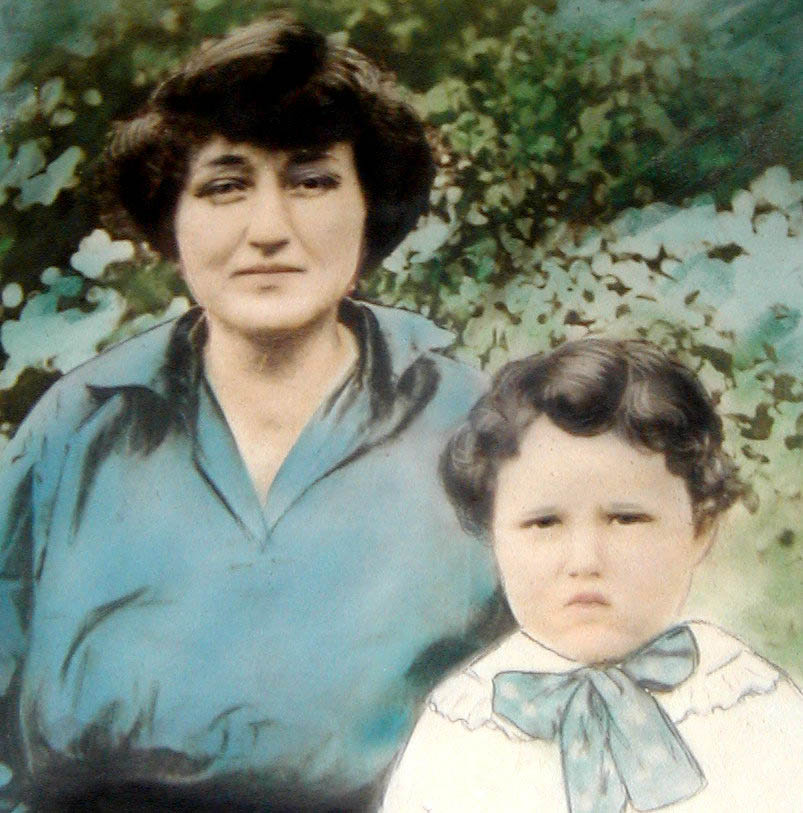
I have the original picture and custom framing of the above pix in our
dining room of which I am very proud. We had the frame restored years
ago by Denise Beachum of Fancy Crafts adding new backing and mats to conceal
the actual perimeter picture damage, etc., and at the time of Grandmas
death; it seemed that no one wanted the old picture and frame which was in
need of major repairs. I am thankful that we obtained it. Pix
below of the framed picture:
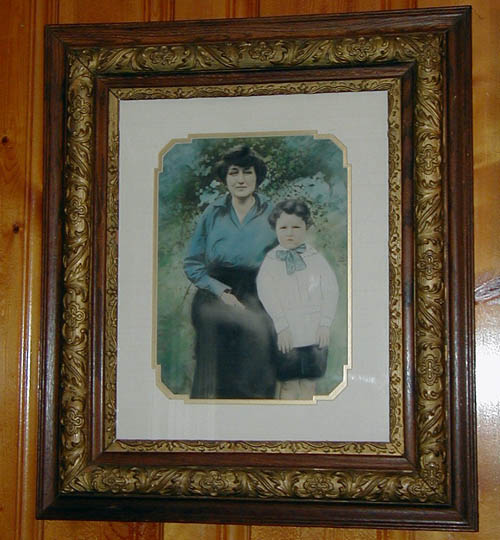
I recently scanned some of Mom's photo albums and found one picture that I
believe is Grandma Coley and her son Joe probably taken around 1914 by the
size of her son. The picture is badly deteriorated, stained, faded and did
the best I could using PhotoShop CS2 to edit it. If this picture
is not of Grandma Coley and her son Joe, I am curious as to who it could be
and/or why the ole photograph was in one of Moms many photo albums as it
must have been significant. The photo is an actual postcard with
nothing written on the reverse side!

UPDATE: Aunt Mollie Bowers viewed the picture above and
verified that it was her Mother, Mary Frances "Della" Coley and the little
chap is her first son Joseph Jullian Faulkner. I can understand why
Mr. Coley said, "That was the prettiest woman he
had ever seen." 08-05-15.
As far back as I can remember, I lived with my Grandma Coley at 910 Maple
Lane, whereas the Porter
Family were living up the road at
817 Maple Lane
in one of Grandma's rental houses. Mom and Pop later moved into the
house next door at 1000 Maple Lane adjacent to Grandma when her son Douglas
and Hattie Coley built their home across the street in front of Grandma who
were using the 1000 Maple Lane house at that time. Grandma Coley
raised me like I was her own son and she was like my Mother to me, even
though Mom and Pop was always close by. My Mom asked me over the
years, "I know you love her more than me"
of which I never gave her an answer and I am sure she did know the answer.
I did love Grandma Coley more than my Mother because Grandma Coley raised me
as her own son. Grandma Coley also let me know how much she loved me
as well over the years and in the Anson County Hospital during our last
visit. My bride reminded me every once in a while how my Grandma
“spoiled” me since I never picked up any clothes, washed any
clothes, dishes or did too much in the way of chores around the house.
I just hunted, fished and trapped growing up without any responsibility of
which my bride’s work was cut out for her to get me trained, although I
think four (4) years in the US Navy got me started on the right foot as far
as responsibility issues are concerned since you always march left foot
first! My bride will freely admit it did take her a long time but I
finally did come around. Go ahead and grin if you must!
JESSE McKNIGHT "MACK" COLEY
Below a couple pixs of Jesse McKnight "Mack" Coley and what information I
have relating to him:
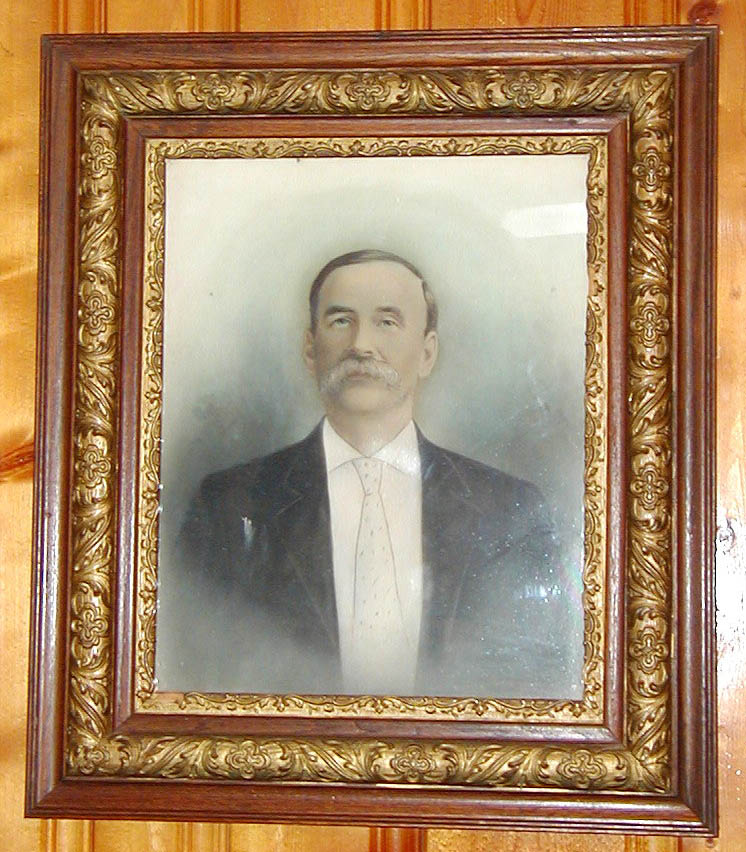
Below is a close-up pix taken off the above picture of which my bride
touched up some of the coloring and other details that had faded over time
prior to having the entire frame and backing restored by Denise Beachum of
Fancy Crafts:
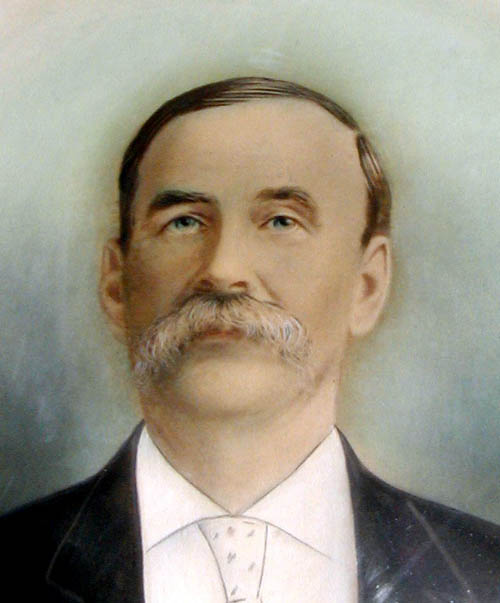
Recently, Mr. Coley's only surviving son,
Jesse Mack Coley, Jr. age 92 passed away on
May 22, 2015. Prior to his death, I got a few pieces of information
about his
Dad and was planning to spend a day with
him to fill in the gaps on a lot of things I wanted to know as much has been
forgotten that my Grandma Coley related to me back in the mid 50's
throughout the 1960s......it sure doesn't pay to procrastinate and my bad on
this one.
To reiterate, the above information was originally added to this
page on October 23, 2004 except for the picture found of Grandma Della and
her first son Joseph Julian Faulkner added during the Month of August 2015.
The contents below were added to this page after May 22, 2015 as stated above.
See the
Serpentine China Cabinet page where a new piece of curved side
panel glass was installed which was the introduction into this page and
decided to separate the information into two short stories.
JESSE M. COLEY, MY GREAT GRANDFATHER INFO
Jesse McKnight "Mack" Coley was born in Iredell County on December 7, 1861,
the son of
J. M. Coley whereas the Civil War started
on April 12, 1861. Iris (Aunt Mollie Bower's daughter) and Terry Teff
mailed me a copy of Jesse M. Coley's archived
military records of which he was wounded,
captured, prisoner exchange, wounded, recaptured and eventually had one of
his legs amputated while in prison. While in prison, he learned how to
make and repair shoes of which he applied that trade later as a
shoe cobbler. He was released at
Elmira, NY on May 29, 1865 after taking the
Oath of Allegiance. I have a summary of his military record that is
listed on page 222 North Carolina Troops: 1861-1865 courtesy of Iris and
Terry Teff on this .pdf file
hyperlink. Jesse M. Coley, my Great Grandfather walked
and/or hitched any ride he could back to NC, returning home to a farm that
was destroyed by the Northern Army; e.g., livestock killed or taken, crops
destroyed and even the mattresses were cut open.
Matt McCall, Register of Deeds in Iredell County was kind enough to send me
an
index
of Coley land transactions and a copy of two deeds,
DeedBookD26Page372 and
DeedBookD9Page692 of which are those of
Jesse M. Coley and his wife Elizabeth Coley. His son Jesse McKnight
"Mack" Coley listed his father as Jesse Coley and his mother Martha E. Coley
from Iredell County both being deceased on his
marriage license to Mary Frances Trexler
issued on August 21, 1919 which established the connection, although family
has related that information about Jesse M. Coley serving in the Civil War
as far back as I can remember. No one in the Coley family knew where
the name Elizabeth came from that
was passed down to the siblings and now we possibly know if in fact Martha
E. Coley's middle name was Elizabeth. The date time frame of the deed
transfers certainly is in line with Jesse M. Coley there in Iredell County
at the time. I plan to search Jesse McKnight "Mack" Coley's brother William
Coley that died here in Wadesboro? and see what information is listed on his
death certificate as to his parents names which should be the same as listed
on his brother's marriage certificate.
NOTE: I checked the Anson County Register of Deeds Death Record
Index books and couldn't find William Coley listed. According to Aunt
Mollie Bowers, he had a son they called, "Little Mack" who drown in the
Ballast Pits in Lilesville and buried here in Wadesboro but didn't find an
index to his death certificate either. However, I did find the
death certificate of Arthur Cletus Coley who was one of Grandpa
Coley's sons from his first marriage in Cabarrus County who died of an
apparent heart attack in the Wadesboro Bus Station. Aunt Mollie Bowers
related to me that Cletus had come to visit Mr. Coley and borrowed 500
dollars from him and stayed 5 days before leaving to go back to East
Lumberton, NC where he lived. Aunt Mollie said he still had the 500
dollars on his person at the time of his death and it was returned to Mr.
Coley by the wife of Cletus Coley. Cletus is
buried in the New Hollywood Cemetery in
Lumberton, NC.
1870 CENSUS TAKEN IN JULY CODDLE CREEK TOWNSHIP IREDELL
COUNTY, NC WITH JESSE COLEY FAMILY LISTED
On 07-29-15 while doing some internet searching, I found an 1870 census that
was taken on July 26, 1870 of the
Coddle Creek Township there in Iredell
County, NC and it listed the entire family of Jesse Coley, my Great
Grandfather on my Mother's side of the family. A few paragraphs above,
I mentioned I was trying to validate that Jesse McKnight Coley's Mother's
name was Elizabeth since I had only found one document that listed her name
as Martha E. Coley and this validates that the E. was in fact
Elizabeth. No one in the Coley and/or Ackerman
family knew where Elizabeth Coley Ackerman's first name came from and now we
do know for certain. I have the 1870 Census document at this
hyperlink. Also, Mr. Coley's brother
was known to the family simply as Will and his name appears as Washington W.
who was 6 months old at the time the 1870 census was taken. There were
a couple more young children on the census report at the household; e.g.,
Sarah E. and Mary C. that no one in the Coley family here in Anson County
has ever mentioned and probably not aware of. Then again,
William and/or Will could have been born after the 1870 census report was
taken but in all likely hood, Washington W. is probably William aka Will
since Aunt Mollie Bowers said that Will was younger than her Dad Jesse
McKnight "Mack" Coley.
NOTE: Steve Bailey sent me info about Will aka William Green
Coley who was born on May 4, 1873 in Iredell County, NC and died on July 15,
1957. He is buried in The
Anson Memorial Park here in Wadesboro.
William was a carpenter by trade and built a cedar
wardrobe
for Jessie Mack and Della Coley, of which was in my bedroom at Grandma
Coley's home.
Web page updated by Bill aka Mickey Porter on 11-07-18.
According to Aunt Mollie Bowers, J. M. Coley, her Grandfather lived his last
years, circa 1920 with
Clifford & Dora Coley (Clifford being Jesse
McKnight "Mack" Coley's son by his first marriage) while they were living in
Concord, NC, whereas Clifford Coley after he retired from the US Postal
Service, rented a farm in Georgeville (desiring not to purchase additional
property) which is about 2.3 miles plus or minus from Reeds Gold Mine in
Midland, NC. There is very little written information about Jesse
McKnight "Mack" Coley but it is to my understanding he had two brothers;
Will and Andrew and one Sister Annie, whereas his brother William aka "Will"
years later relocated to Wadesboro, NC and worked for Little Cotton Mfg. Co.
The 1870 census does not list a sibling name Annie and she was no doubt born
after the 1870 census was taken and/or died prior to the census taken.
It is to my understanding he named my Mother Annie of which she had it
changed to Ann according to her birth certificate that was amended years
later. Jessie McKnight "Mack" Coley and
Alice Eugenia Fisher Coley did have a
daughter
Annie Eugenia Coley Long born 1889 and died
in 1911.
Aunt Mollie Bowers related to me on 06-30-15 that while she was helping look
after Mr. Coley during the time he suffered his stroke in May 1945 until his
death in June 1946, he would talk about some of his childhood memories from
the past. Mr. Coley told her that when he was around 7 or 8 years old,
that his Father
"farmed him out" to two old maid
sisters, Ms. Mary and Ms. Jane White who were former school teachers before
the Civil War, teaching around the Concord area, whereas Coddle Creek
Township in Mooresville is around twenty one (21) miles away. He
stayed with them until he was around 13 or 14 years old and during that time
he earned one dollar $ 1.00 per month which went to his Father to help raise
the other siblings. Mr. Coley said the White sisters were very good to
him, teaching him how to read and write and he always had plenty to eat.
He cut and split fire wood, tended to the chickens and cows, delivered eggs
and butter to customers for them and any chores related to the operation of
a small family type farm. Aunt Mollie said during that time, he wore
mostly a very long type of shirt and didn't have any regular trousers and
while doing his chores, there was an old goose on the White sisters property
that would try and bite him of which he had to run away from the goose
without breaking any eggs. According to the 1870 Census taken there in
Coddle Creek Township, Jesse McKnight Coley was 9 years old and still
at the home at that time. Verbal information as to dates can be off a
few years when relating events from memory that happened many decades
earlier but as the ole saying, "It
all comes out in the wash."
1880 CENSUS TAKEN ON JUNE 4, 1880 TOWNSHIP # 11 OLD FIELD,
CABARRUS COUNTY, NC
On September 17, 2015 while viewing the 1880 Census Report for Cabarrus
County, NC, I located the page where Jesse M. Coley (spelled Jesey) M. was
listed as a farm hand for Mary White and her assistant Mary A. White which validates the information about
Jesse McKnight Coley working for the Whites per Aunt Mollie Bowers although
her time line of him staying with them until he was 13 or 14 years old doesn't match the 1880 Census report,
however Aunt Sis Ackerman's account of
her Dad working for the Whites until he married Alice Eugenia Fisher
in 1881 is more accurate and makes better sense. I have the document hyperlinked
here.
The pieces of the puzzle are coming together for sure!
1900 CENSUS TAKEN ON JUNE 13, 1900 TOWNSHIP # 12 CABARRUS
COUNTY, NC
On September 18, 2015 while doing census internet searching, I located the
family of Jesse McKnight Coley and Alice Eugenia Fisher Coley and amazed
that his occupation at that time was listed as a
Dairyman and two of his sons were labors in the dairy.
They also had seven (7) children as of this 1900 census report of which I have the census document hyperlinked
here. Mr. Coley was already into
real-estate by this time as evidenced by deed transactions documented a few
paragraphs below and totally amazed at his diversity in generating income.
The census report also shows the property as owned without a mortgage. This is the
second record I have uncovered with his occupation listed while
he was in Cabarrus County other than real-estate transactions and verbal
information from Aunt Mollie Bowers and Aunt Sis Ackerman per her written
account below.
One thing is for certain, he was one smart, energetic and hard working man!
ELIZABETH COLEY ACKERMAN'S ACCOUNT OF HER DAD, CIRCA 1999
Below is a copy and paste of Elizabeth Coley Ackerman's
account
of her Dad written between Feb. and April 1999, quote "My father’s name was
Jessie McKnight Coley and when he was about nine years old there was a
wealthy widow, a school teacher, asked my grandfather to let Daddy stay with
her to do her chores and she paid my grandfather $1.50 a month and she was
good to my father and she taught him his schooling. She must have
given my father violin lessons for he could play the violin so pretty.
My father worked for her until he was 19 years old and he asked is father to
let him have $1.50 the last month he stayed with her so he could get
married. Well he got married and had eight children and they all
worked on the farm. Daddy bought land and Daddy did very well he
bought land and he owned the land that Cannon Mills was built on. He
sold it to Jim Cannon in Kannapolis, NC and Cannon Mills is still there
today. He told me he bought the land with .05˘ cotton they raised a
lot of cotton and Cannon Mills used cotton to make the sheets, towels and
lot of other things. He had five sons and three daughters one daughter
died when she was 15 years old. She made the dress she was buried in.
Daddy saved his money and the Lord blessed everything he touched. One
reason God Blessed him so much he took care of his father when he was young.
He bought property in Concord, NC and he owned a bottling plant that made
cakes and other drinks. He gave each one of his children a home to
live in. In early 1900 he had a friend and they went to Texas and they
worked the rice fields out there. He saved his money and left his wife
to collect the rents and save it and when he got back from Texas, with all
he made out there he found his wife had been living with a man and she was
addicted to morphine and he told her they would divide all the property they
had after he had given the children a home and he took his part and came to
Anson County, NC and bought nine houses with his part of the money. He
met Mama and Mama was working in the silk mill to keep her the two younger
brothers and her father. She took care of 2 sisters and they died and
her father died and she was still taking care of her brothers." End Of
Quote.
The 1880 Census validates the verbal accounts of the time he was farmed out
to the Whites until he married
Alice Eugenia Fisher on December 20, 1881 in
Cabarrus County and they raised eight (8) children. Mr. Coley
(according to information that was told to her from Mr. Coley, her Dad)
he cut and sold firewood to Cannon Mills which used wood fired boilers to
produce steam and they had a tremendous sales outlet which rendered a
sizeable cash flow at that time. Mr. Coley also used his sons later
when they got old enough to help with cutting and hauling the firewood to
Cannon Mills. Mr. Coley started acquiring and selling property as
early as 1885 as evidenced from deeds recorded in the Cabarrus Register of
Deeds Office there in Concord which is hyperlinked in the below paragraph.
He owned a good amount of land at that time and was able to cut timber from
his own property to render the firewood. He would be considered
wealthy by today's standards and before and after he divorced his first wife
on amicable terms, he left each of his children a home including a home and
property to his wife and I viewed a couple property transfers to his son
Clifford A. Coley and Alice Eugenia Coley on 05-23-1919. Alice Eugenia
Fisher Coley did not live long after their divorce and died on May 14, 1920
being 60 years old at her death, whereas the cause of her death was Cerebral
Hemorrhage (Apoplexy) via information provided by
LoRetta Hughes on September 26, 2015 via
email.
We have two accounts of
how Jesse M. Coley prospered per Aunt Mollie Bowers and Aunt Sis Ackerman
and he could have supplied firewood and cotton to Canon Mills for income,
therefore I don't discount either. We do have documented evidence from
the 1900 Census Report that Jesse McKnight Coley was a Dairyman and at that
time two of his sons was listed as laborers in the Dairy.
CABARRUS COUNTY PROPERTY ACQUISITIONS AND DISPOSITION BY
J. M. COLEY & A. E. COLEY, ET AL
I checked on line at the
Register of Deeds in Cabarrus County and
printed out an
index of the land acquisitions and
disposition of J. M. Coley and his wife A. E. (Alice Eugenia) Fisher Coley
of his first marriage and looked many of the deeds up and have them saved in
this
folder in .pdf file format. I also saw a couple property
transfers by J. M. Coley and Della Coley after they were
married and residing here in Anson County
and transferring (selling) property that he still owned in Cabarrus County
to Southern Loan & Trust Company for 3500 dollars on 06-09-20 recorded in
Deed Book 94, Page 25. This was no doubt
"seed money" for the
large real-estate purchase he made on March 9, 1921 via the Anson Real
Estate & Insurance Co. with specific lots purchased and detailed which shows
which lots had a house on it at the time the plat was draw.
It is amazing that one who came from such a humble and poor beginning did
not let external circumstances in life hold him back and that was no doubt a
large part of his psychological motivation and drive to want to get out of
poverty and succeed in Life! Of course his ability to read and write
was a tremendous asset for him at the time as well.
After his divorce from his first wife, he traveled to Texas and got into
purchasing wheat futures/shares and real-estate and did some traveling
per
Aunt Mollie Bowers.
Mr. Coley related to Mollie Irene (Bowers) Coley that he stayed at one
particular boarding house for a week while in Texas and they served tomatoes
at every meal and after that he would not eat another tomato, being the only
food item he would not consume in later years. When he left Texas, he
traveled to Chicago and/or St. Louis and viewed one of the large expos that
was still on display
and stated that it was an amazing sight! While in Texas, he earned
large sums of money and after some of the traveling mentioned above, he
relocated back to NC renting a room in a boarding house here in Wadesboro
when he came through the area traveling by horse and wagon going door to
door getting orders for family photograph enlargements and custom picture
frames. He would send the photographs off to a company via train that
specialized in photo enlargements. He received the enlarged
photographs back via train at the old
Wadesboro train depot and would make custom picture frames for
the enlarged photographs at a reasonable profit. The above two custom
framed enlarged photographs and the frames are some of his work, however he
did not do the hand coloring on them himself and we had them professionally
restored many years ago. Mr. Coley was definitely into real-estate and
did more buying than selling here in Anson County, NC from the deeds viewed,
although he did sell a few parcels of land he acquired in 1921 as early as
1930. While I was still living with Grandma Coley until 1964 when I
enlisted into the US Navy, there were seventeen (17) houses still in the
Coley estate and fifteen (15) were rental properties and numerous parcels of
land. I noticed on some of the original plats done, many of the road
names have been changed since the 1920s and a little confusing; e.g., Carr's
Mountain Road later became Sikes Avenue, Patrick Road later became Maple
Lane, whereas the original deeds and plats have those original roads listed
with some of the later changes.
COLEY LAND ACQUISITIONS AND DISPOSITION
BY J. MACK COLEY & THE COLEY HEIRS IN ANSON COUNTY, NC
Here is a .pdf file of the
J. Mack Coley Heirs property that was done
in 1970, Plat Book 6 Page 91.
Here is a .pdf file of the July 1915 Plat Book 1 Page 37 of the
property owned by George Singleton known as
the West Side Extension that was
deeded to Jesse McKnight "Mack" Coley on March 9, 1921 via the
Anson Real Estate & Insurance Co. with specific lots purchased and detailed
which shows which lots had a house on it at the time the plat was draw.
By comparing the two different plats from the original land purchased by Mr.
Coley, one can ascertain how many lots were sold off (deeded) prior to the
property plat done in 1970 by the Coley Heirs. According to Aunt
Mollie Bowers, most of the money was used to put bathrooms in the existing
homes and pay off accrued back taxes which would be the case
after Mr.
Coleys death but not the deed transfers prior
to his will of March 4, 1946 of which a huge portion of his land assets
without homes on them were deeded to Elizabeth, Douglas and Mack, Jr.
I didn't find a single deed transfer of any
property to his daughters Ann and Mollie. This could be
what Grandma Coley was eluding to in the paragraph below which is now part
of our family history and memories from the past!
Mr. Coley had many parcels of land between Maple Lane and Salisbury Street
of which were disposed of prior to the
J. Mack Cole Heirs property plat done in
1970, whereas there was a provision in the will where Grandma had only
life time rights to said properties.
Grandma did comment while I was living with her prior to 1964 concerning the
Will of J. Mack Coley that was recorded on
March 4, 1946 three (3) months prior to Mr. Coleys death and events
prior to Mr. Coley's death and stated "That Doug got some
"shyster" lawyer and had the will drawn up during the time
Mr. Coley had his stroke", however Grandma Coley was named the Executrix of
the will. Something apparently happened either before or after the
will that would have prompted Grandma Coley to make such a statement years
later as she
rarely made any kind of negative statement or conation, whereas she
also said the same thing to Elizabeth Ackerman according to one of her sons.
According to Aunt Mollie Bowers, Mr. Coley trusted the individual that
helped him write up his last will and testament that was submitted. I
did not check to see if there was a will prior to the last will and
testament of Mr. Coley dated March 4, 1946. The deeds manifest there
was a sizeable amount of land transferred from Jesse Mack Coley and Della
Coley to J. Mack Coley, Jr., Douglas Ross Coley and Elizabeth Ackerman
during the time he suffered his stroke on May 1945 and prior to his will
dated March 4, 1946, with said deed transfers beginning as follows:
December 17, 1945 to
Cecil & Elizabeth Ackerman, December 27,
1945 to
J. Mack Coley, Jr., February 15, 1946 to
Douglas R.
Coley. From information gathered in layman's terms, a
person with life time rights to property where said property is left to
others after that person's death, all parties have to appear before the
court in a special hearing/proceeding or deposition to allow the sale of
assets of the estate while the party with the life time rights is still
alive. I saw evidence of this when the Hotel property was sold after
Mr. Coleys death while Grandma was still alive with the sale on July 23,
1947 documented in the
Coley Hotel Deed History
and the house sale at
817
Maple Lane Sale 1970. and on September 10, 1970 when the
land on
Sikes Avenue was sold listed as Plat # 5 in said deed and Lots 6,
7 and 8 Block C sold on August 10, 1971
Deed Book 172 Page 243, Lots 5, 6, 7, 8
Block D June 3, 1971
Deed Book 171 Page 302,
and the lot on Wheeler Street beside Marjorie
Robinson, Deed Book 169 Page 19 which is the second page of the last .pdf
referenced file above and other lots, whereas Grandma was only
entitled to an equal or "Childs" share. The last four (4) deed
transfers were most likely to create a cash flow to help pay off accrued
taxes and generate income for Grandma Coley who was struggling to maintain
the aging properties. A check of the tax stamp on some of the deeds
manifest she didn't get much money for the properties sold.
Additional Deeds were located with several different lots detailed in this
.pdf
document.
I found one deed transfer from J. Mack & Della to Della Crawford dated April
10, 1930 for a house and one additional lot on Montgomery Lane being Lot 2
and Lot 3 Block E with an exception for access to a well recorded in
Deed Book 76 Pages 113 and 114. of which was a more or less
community well for all the homes in the area on the land Mr. Coley owned
titled West Side Extension. During those early years, there was no
such thing as city and county water as is today. I didn't realize that
Mr. Coley owned that house until I started looked at the various lots and
their deposition later. It was strange because that home was right in
the middle of the West Side Extension properties that he purchased and owned
and explained why the exclusion of the well.
Mr. Coley deeded Grandma Coley aka "Della" two lots which had houses on them
on November 24, 1945 and they were in real good condition in the early to
mid 1960s. This
document in .pdf file format tracks the
house located at 315 Graham Street which was sold by Grandma on April 23,
1964 to Henry L. Little no doubt to help pay off accrued taxes, etc. I
haven't researched out the house beside it yet of which she owned which was
not apart of the Coley Heirs Estate but deeded to her outright by Mr. Coley.
On October 24, 1964 Doug & Hattie Coley sold Lot 9 Bock D and Lot 5 Block E
that they received from Jesse & Della Coley on February 15, 1946 recorded in
Deed Book 151 Page 275. The rest of
those lots were eventually sold by Doug with the exception of Lot 6 Block E
which was the lot their home was built on. I did find a deed where he
had Hattie's name later added to the deed for their home on April 9, 1969
Deed
Book 164 Page 629 of which it appears that all the original land
deeded to him on February 15, 1946 was already disposed of. I remember
statements (negative conations)
made by Grandma Coley concerning the sale of those lots during the 1950s and
1960s and will leave it at that!
PROPERTY MAINTENANCE AND LACK OF
I am sure Grandma was alluding to the will and the way the judicial system
procedures work as well because in the middle 1960s, she was struggling
financially to keep the property maintained which was a loosing battle on
about all the old wood frame rental houses. One of the persons that
did most of the maintenance work on the units was
"stealing her blind" over the years maintaining his own
properties at Grandmas expense. I have first hand knowledge of this
since we "audited" her open account at H. W. Little and could not find where
that individual had used the items purchased on her units. In some
foreign counties, they use to cut the hand off of a thief and other
countries, you would only steal once! Nevertheless, Grandma continued
to use the thief, hopefully with a better check of his purchases.
I didn't track down all the land acquisitions and disposition of said lands
of the J. Mack Coley Estate but followed up on most of it. I enjoyed
looking back in time and I certainly do have great respect and admiration
for Mr. Jesse McKnight "Mack" Coley and certainly do wish I could have
gotten to know him personally. I feel that I do know him from all the
wonderful stories that my Grandma Coley and others have related to me over
the years, however memory fails over time and without documentation in the
form of pictures and other forms of media storage to preserve those
memories, they will be lost in obscurity forever.
OLD PETE THE FAMILY MULE
During the time Mr. Coley owned the peach orchard "farm" in Morven, NC which
is 11.3 miles from 910 Maple Lane in Wadesboro, they used their mule
named Pete to do the plowing and cultivating the land between the peach
trees, etc. I remember Grandma telling me about Pete and Aunt Mollie
related to me that Uncle Mack Coley before 1946 would ride Pete to Morven to
do the plowing and after a period of time, Pete realized that when they
started riding him up Maple Lane, they were headed to the farm and he
wouldn't go any further apparently knowing what work was in store for him.
Anyone that has ever been around a mule will quickly understand where the
term,
"Stubborn as a Mule" comes from.
The only way they could get Pete to travel to Morven to the Peach Orchard
Farm after he wised up, was to put blinders on him and ride him to the
railroad track that was about 1/2 mile behind their land and travel the
railroad tracks until they got close to Highway 52S and then they would
remove the blinders from ole Pete. By that time Pete was calmed down
or simply forgot about the farm work.......grin if you must! Ole Pete
died during the time Mr. Coley suffered his stroke and was buried behind the
barn on the Coley home place at 910 Maple Lane. Aunt Mollie remembers
that they were looking after J. Mack Coley, Jr.'s first child Maxine
who was about 2 years old at the time and Maxine would say,
"Old Pete dead behind the barn." I remember Grandma
talking about when they buried Pete; they had to cut his legs off in order
to fit him in the hole dug and she was very upset over that fact.
OLE BLUE, MR. COLEY'S HOUND DOG
Aunt Mollie related to me that Mr. Coley had one ole hound dog that he
really loved saying that Ole Blue had a beautiful voice. Back before
refrigeration was standard in most homes, they used an
icebox
that they kept blocks of ice in to keep the icebox contents cool. The
melted ice would drain out into a bucket they kept underneath the back porch
which collected the water and someone would have to empty the contents of
the bucket regularly to keep from having a mud puddle under the back porch.
To make a long story short, one of his sons Clifford Coley who lived in
Concord, NC would write them a letter and let them know ahead of time that
he and his wife Dora were coming down for a visit and Grandma Coley would
have some large butterbeans cooked for them along with cornbread since that
was one of Clifford's favorite meals. Clifford, Mr. Coley, Mack and
Doug would usually go rabbit hunting and would be back around dinner time
(middle of the day) to enjoy a meal. That particular time, Grandma
Coley had cooked a very large ham and had it stored in the icebox on the
back porch to go along with the butterbeans and cornbread at meal time.
Now we are getting to Ole Blue's part in the story. Mollie said that
Ole Blue was pretty smart for a hound dog and could open the back screen
door latch and come in when he wanted to and also had learned how to open
the latch on the icebox and open its door. Well, while Mr. Coley,
Clifford and Mr. Coley's sons were out rabbit hunting, ole Blue sneaked
onto the back porch and opened the icebox and helped himself to the cooked
ham. When Mr. Coley and the boys had returned from their rabbit
hunting, ole Blue had eaten about half the ham of which the balance could
not be used. Mr. Coley made some comment about what happened and
Grandma Coley told Mr. Coley,
"Well, Ole Blue is your dog"!
JESSE MACK COLEY, JR., AIR RIFLE AND MATCHES STORY
Aunt Mollie Bowers related to me on 08-06-15 and another time that Mr. Coley
had gotten Mack Coley, Jr. an air rifle for Christmas and that particular
year it was extremely cold. On Christmas morning, Mr. Coley heard
window panes breaking and went into the large dining room to see what was
taking place and Mack, Jr. outside shooting out the large glass window panes
on every window frame. Mollie said Mr. Coley went outside and took the
air rifle away from Mack, Jr. and broke the air rifle over his knee, thus
ending Mack Jr.'s, air rifle shooting days.
Mr. Coley had to call the proprietor of the local Hardware Store and he
opened his business and let Mr. Coley have the necessary glass window panes
to make the necessary and much needed emergency repairs.
Mr. Coley had planted cotton one year and had the bales of cotton stored on
the front porch of the house at 1000 Maple Lane and Mack, Jr. was "old
enough" to have matches on his person, whereas Mack was striking the matches
too close to the cotton bales and ignited one of them. They were able
to put the fire out in time before serious damage was done. Mr. Coley
laid a good whipping on Mack Jr. and Mack told his Daddy while he was
whipping him," You are setting me on Fire"
and Mr. Coley replied "That was what I meant to
do." Mr. Coley didn't know that Mack Jr., had his
kitchen matches stored in one of his back pants pockets and they apparently
had rubbed together during the whipping and self-ignited and Mr. Coley really did
set Mack Jr., on fire......Aunt Mollie and myself got a good grin out of
that one for sure.
RENT COLLECTION
I remember as a teenager collecting rent money from the tenants and heard
excuses of all kinds why they couldn't pay the rent on time. I
remember one individual that saw me uptown Wadesboro many years after
Grandma Coley had died and he immediately recognized me. He said he
owed me some rent money and I told him he didn't owe me anything that
Grandma Coley had died many years ago. I guess the burden of guilt was
still upon himself and hope that guilt was then removed. A conscience
is a good thing but one must respond to it in a timely and correct manner!
Grandma Coley would let renters stay on for many weeks and months without
evicting when they didn't pay the rent; she was just too tender hearted to
throw them out (evict) as a normal rental property owner would do! I
remember one rental house on Montgomery Avenue where the tenants had removed
boards off the back side of the home and used the boarding for fire wood.
I remember going to one of Grandma Coley's rental houses for the collection
of rent and the lady that came to the door said that she owned the
house....grin if you must! That house is long gone and only a vacant
lot today.
PROPERTY ACQUISITION AND DISPOSITION CONTINUED
Below is what happened to most of the lots I could not find between the
J. Mack Cole Heirs property plat done in
1970 and the land
deeded to Jesse McKnight "Mack" Coley on March 9, 1921 and other
land acquisitions not a part of the 1921 purchase. It appears that his
second land purchase here in Wadesboro was the Seaboard Hotel later
referenced as the J. M. Coley Hotel detailed in this
Hotel document on December 27, 1919.
In all probability, this is where he met Mary Frances "Della" Trexler
instead of the house at 910 Maple Lane, Lot 1 Block G per the 1915 Plat done of
the West Side Extension properties conveyed to him on March 9, 1921, however
Aunt Mollie Bowers believes it was at the 910 Maple Lane address which is
really immaterial; they met and later married and as they say,
"The Rest Is History." The
property deeds found does not support some of the verbal history accounts of
who and when they were occupied by the Coley and Trexler family but verbal
information has a way of getting distorted and/or forgotten over the many
decades especially if not an eye witness and then again, eye witness
accounts vary just as much over the years as verbal accounts.
While viewing deeds related to the Jesse McKnight "Mack" Coley estate prior
to his death in June of 1946, I found a deed dated February 15, 1946 Deed
Book 100 Page 551 through 553 from J. Mack and Della Coley to Douglas R.
Coley which details twenty three (23) lots of land
which includes the lot that he (Douglas Ross Coley) built his home on
located at 909 Maple Lane which is in front of Grandmas ole home place at
910 Maple Lane. This
document
is in .pdf file format details the land transfer. The SIXTH TRACT
of land in the above document is referred to as the J. W. Odom Estate,
Julius A. Little Track of December 1927. Click on this
link to open the .pdf file of the plat
drawing. In
Deed Book 102 page 481, it was found that
Doug & Hattie Coley sold five (5) of the lots received on February 15, 1946
in Block C of the West Side Extension land on August 7, 1946. This is
about one fifth of the parcels of land he received and disposed of which I
don't plan to look any further as I was curious as to what happened to the
lots prior to the J. Mack Coley Heirs Plat of 1970. I remember Grandma
Coley making comments concerning the disposal of those lots and again will
leave it at that.
There were 8 homes on Montgomery St., of which have been demolished and
replaced; 4 homes on Maple Lane with three occupied; 3 on Sikes Avenue,
demolished and replaced by 2 homes; 2 on Wheeler Street demolished and not replaced and
2 on Graham Street. I cruised by there yesterday to get a mileage from
the housing development where the Singleton Silk Mill once stood to the old
home place on Maple Lane and it was right at 1/2 mile and the two homes are
definitely not in as good a condition like they were when they were sold
after 1974. Grandmas home place is currently being renovated.
The J. Mack Coley Heirs Plat of 1970 shows what lots/houses were still in
their estate of which all properties have been sold to this date. Time
certainly does not stand still for any of us! 06-08-15. Below is
out of chronological sequence but that is ok too!
GOING BACK IN TIME WITH THE TREXLER FAMILY
My Grandma, Mary Frances "Della" Trexler lived at 1000 Maple Lane with her
invalid Father,
John Henry Trexler who had pulmonary
tuberculosis for 4 years prior to his death on March 20, 1915 and siblings
Callie,
Charlotte "Sis",
Jennie,
Lena and four
Brothers;
Moses,
John,
Clyde and
Ellis, whereas her Mother, Irene Mollie
Moore Trexler (name listed as Mary Moore on their
Marriage License) was deceased sometime before the 1910 Census was taken.
It is a miracle that the rest of the family wasn't infected with TB which is
highly contagious.
The
Trexler family prior to moving to town at
1000 Maple Lane lived out 109S near the Hanna Chapel United Methodist
Church. John Henry Trexler farmed and worked indirectly for the County
and ran a Brewery that manufactured and supplied various types of "Spirits"
for the County that was legal at the time according to Aunt Mollie Bowers.
John Henry Trexler's death certificate list him as a farmer. The
entire Trexler family moved to 1000 Maple Lane sometime after the 1900 census and before the 1910 census
report was taken, whereas her Mother Mary (Irene Mollie) Moore Trexler was deceased
and in the 1910 census report list
Lucy Trexler. I am making a
calculated guess they moved to the Wadesboro Township around 1902.
JOHN TREXLER LAND TRANSFER TO HIS CHILDREN
John Trexler, the father of John H. Trexler transferred parcels of land to
his children Caleb, Eva Ann, and Francis on April 3, 1883 hyperlinked
here.
On 08-11-15, I located a deed property transfer,
Deed Book 45 Pages 126 and 127
from Harriet Trexler (Mother of John H. Trexler), John H. Trexler and
his wife Lucy Trexler to J. Frank Trexler dated March 25, 1909 for 2 lots
totaling 50 aces for $ 700 dollars; being lot No. 3 and lot No. 4 in the
division of John Trexler's land. On 08-13-15, I located a deed
property transfer, Deed
Book 26 Pages 311 and 312 from John Trexler to John H. Trexler
for one of the above lots No. 4 that was granted to him on March 28, 1888.
Per the
1870 census report of the John
Trexler family located in the Gulledge Township, John Trexler is 10 years
old and his brother Caleb is 8 years old of which the deed makes reference
to the above tract bordering the land of Caleb Trexler. I have little
information about the siblings of John H. Trexler, Sr., other than John H.
Trexler (Father of Grandma Coley) and don't remember my Grandma Coley making
mention of them at all. I will continue to seek information about who
J. Frank Trexler was related to.
1900 AND 1910 CENSUS INFORMATION JOHN H. TREXLER FAMILY
I received information from Julie Ganis that has access to the data base for
the NC Census reports and she sent me a copy and paste of the information
that was taken in 1900 and 1910 of the John H. Trexler family which is
hyperlinked,
mentioned and referenced above. To reiterate, it lists John H. Trexler
as a farmer and the older children were farm hands. Also, his wife's
name was listed as Mary Trexler, age 35 who would be Mary Irene Mollie Moore
Trexler, several middle names used. There is no Mary Frances
Trexler listed but Della of which that was Grandma Coley's nickname which
appears in legal documents manifested and hyperlinked through out this short
story. After viewing several census reports taken, the usage of
nicknames appears to be common place and their ages many times are incorrect
as well from one census report to the next one taken, not being consistent.
The year of birth on many of the official records such as marriage and death
for the same person is off a couple years in many cases just as the census
reports. The person doing the documentation is relying solely on the
information supplied to them at the time by the informant but looking back
at documents over a hundred years old that still isn't too bad. The
recording of deeds definitely is more precise as to the date of the event
but the reference to some of the land plats as to where the land is located
is very hard to ascertain today as those ancient landmarks and references
are long gone!
In the 1910 census, the family is listed in Wadesboro Ward 1, with John H.
Trexler listed as a carpenter and he has remarried to Lucy Crider on March
7, 1907 per their
Marriage License, whereas his
first wife (Mollie Moore Trexler) had died.
Grandma was working for the Silk Mill sometime around 1902 being 8 years old
at the time if I go with her birth year as 1892, however later research is
being around 1894 as her year of birth. All the children except Ellis who is 10 years old on the
census report, worked at the Silk
Mill. Grandma Coley is listed as Della and is 17 years old
per this census report. There is no mention of Jennie Trexler who was
9 years old in 1900 and later in this short story I determine that she had
married in 1908 and no longer in the Trexler household census taken in 1910.
TREXLER FAMILY MOVE TO 1000 MAPLE LANE, WADESBORO, NC
CIRCA 1902
The entire family
other than John, Lucy and Ellis were working at the Singleton Silk Mill and
her Father later became invalid around 1911 and died on March 20, 1915 by
the information listed on his death certificate and verbal information from
Grandma Coley as to the medical condition of her father John Henry Trexler.
I am estimating the year to be somewhere around 1902 which would make
Grandma 8 years old and working at the Singleton Silk Milk until they
enforced the 12 year old Child Labor Law at the time when she was around 10
years old. The house at
1000 Maple Lane was shown on the above plat mentioned in 1915 which the
entire plat was conveyed by George Singleton and his wife to the Singleton
Silk Mill in April 1908. The Singleton Silk Mill sold the entire plat to the
Anson Real Estate and Insurance Company in 1915 and
sold the lot/house on 1000 Maple Lane to
the Jordans on May 3, 1919. You can easily make the assertion that the
entire property mentioned was a "Mill Village."
From what has been related to me, the properties at that time was in very good
condition. Grandma
Coley was living with her family at 1000 Maple Lane when she went to work
for the Singleton Silk Mill along with her older siblings as her Father's health as she described was very
bad and he was no longer able to farm which was the reason the entire family moved into
town and obtained jobs at the Singleton Silk Mill. Grandpa Coley, Jesse
McKnight "Mack" Coley purchased that house on April 14, 1930 directly from
the Jordans according to the deed
transfer which is beside the lot Mr. Coley
purchased on March 9, 1921 which included 10 houses and
many parcels of land, although the 1915 plat doesn't show a house symbol on
one of the lots that did contain a house when purchased in 1921.
MARY MOLLIE MOORE
On 08-06-15 I photocopied the
Marriage License of John H. Trexler and
Mary Moore at the Anson County Register of Deeds who were married on May 2,
1880 in the Gulledge Township at the home of Mary Moore's Father, James R.
Moore, whereas her Mother Mary Moore was deceased at the time. Mary
Moore was 17 years old and John H. Trexler was 20 years old of which Mary
Moore Trexler (John H. Trexler's first wife) was living per the 1900 census taken but died sometime before
1907 and I am guessing around 1902 since Grandma Coley started to work at
the Singleton Silk Mill when the family moved to Wadesboro Ward 1 Township,
whereas she was 8 years old at the time and she related that information to
me back in the early 1960s that her Mother, Mary Mollie Moore Trexler was dead at the time.
Aunt Mollie Bowers and Charles Ackerman related to me the vicinity where the
cemetery was located and 40 years ago the farm road wasn't paved and the
cemetery which had a wrought iron fence around it with at least one grave outside
the fence was heavily grown over. I made a couple trips to the area by the general
directions they gave and located the Ole Moore Cemetery which is located off
Bethel Road between 742S and 109s with the road being Cuddy Farm Road.
Aunt Mollie didn't remember any grave markers for either Grandma Coley's
Father or Mother and there were some milky quartz stones placed outside the
fence which were no doubt used as grave markers.
I did find one marker inside the cemetery wrought iron fence of Mary Moore
who was the first wife of James R. Moore which is Grandma Coley's
Grandmother on the Moore side. The stone is too new to have been
placed there in 1875 or has some exceptional cleaning done which might be
the case and the date of birth on the marker doesn't match the information
on the 1870 census information as to her age at that time. Grandma Coley's Mother's Father
(James R. Moore) died sometime before
1919 per the probate of his will referenced below. According to the
1870 US Census report taken, Mary Moore was 41 years old making her year of
birth 1829, whereas on her daughter's marriage license to John H.
Trexler in 1880, she lists her mother as being dead; which is in line with
the year of death on the marker, however her year of birth is off by 5 years
too early if the 1870 census information is correct.
I have been unable to find the burial site of Mary Mollie Moore Trexler but still
searching.
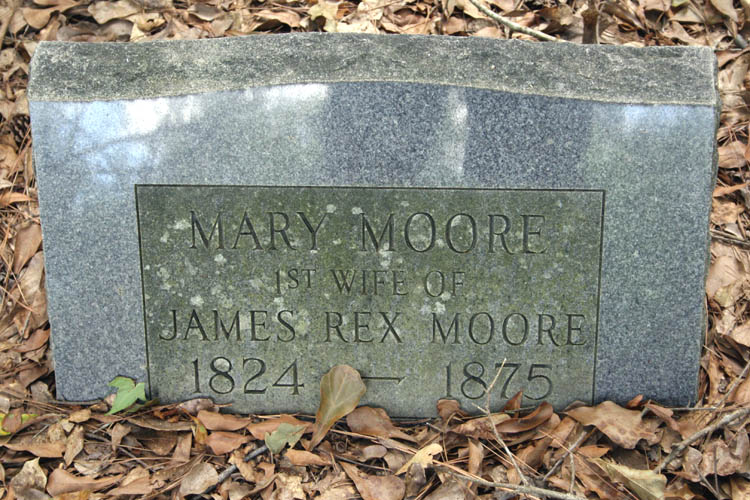
Below is the Ole Moore Cemetery on Cuddy Farm Road off Bethel Road.
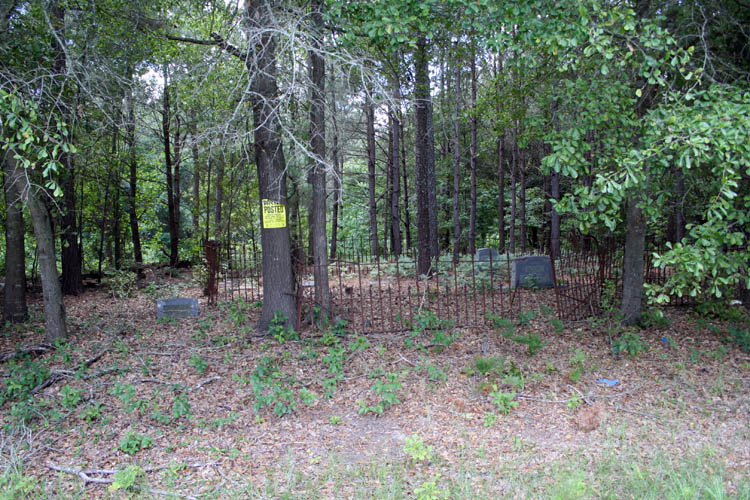
DIVISION OF THE LANDS OF JAMES R. MOORE JULY 18, 1919
On August 12, 2015 while continuing to search documents at the Register of
Deeds Officer here in Wadesboro, I viewed
Deed Book 56 Pages 281 thru 285 and also Plat Book 5
Page 104 detailing the land division of James R. Moore (deceased)
who was the Father of Grandma Coleys Mother, Mary Moore which also has her
name listed as Mollie and Irene Moore in various documents that I have
viewed, on and off-line searches.
Grandma Coleys Parents, John H. Trexler and Mary aka Mollie Moore
Trexler lived on a farm up until around 1902 in the vicinity of the Hanna
Chapel out 109S, whereas the division of land mentioned above contained
544 18/100 acres with all the
tenants in common appearing in the petition. Since his daughter Mary
Moore was deceased, he left her interest in Lot No. 10 which
contained 42 acres per Plat Book 5 Page 104 which was allotted to J. E.
Moore (his son) and each of Mary Moore's children and their spouse was entitled to
1/7th interest in that parcel of land which is detailed more below..
At the time of the petition to divide the lands, James R. Moore and his wife
were deceased and the division of lands was brought about later by the probate of
his will. Several of the children of John H. Trexler and Mary
Moore Trexler both being deceased at this time were listed in the petition; e.g., Charlotte Tarlton and husband Bill Tarlton, Callie Hanna and her
husband Zeb Hanna, Della Faulkner (Grandma Coley), Fred Teal, blank space
underscore
Teal, whereas Jennie Teal was deceased, and Ellis Trexler, whereas they had
an interest in one of the parcels of land being Lot No. 10. The deed
details the land and the percentage that the above children of the Henry H.
Trexler and Mary Mollie Moore Trexler family were to receive of which I tracked down
most of the later
deed transfers that detailed what each
received in payment which was $ 100 dollars each being 1/7 of the value of
the 42 acres of land as described in Lot No. 10 of the above division of
lands of James R. Moore. I haven't been able to ascertain exactly
where the land is located per the deed and the plat reference; there just
isn't enough information without the help of a surveyor. The
bulk of the 544 acres of land went to his son J. Ed. Moore per the deed
referenced above.
I have an 1870 US Census Report for James R. Moore, Gulledge Township
hyperlinked
here.
CALLIE TREXLER HANNA
Callie Trexler was born on September 12, 1885 and married Zeb Vance Hanna.
Both are
buried in the Hanna Chapel United Methodist
Cemetery, whereas Callie died on April 24, 1971 and Zeb was born December
15, 1883 and died May 6, 1967. I do remember going out to visit Callie
and Zeb Hanna back in the mid 1950s to the early 1960s, whereas they had a
farm not too far from the Hanna Chapel United Methodist Cemetery off Jones
Road which I believe was a dirt road back then. I remember Zeb wearing
overalls and was thin and lanky looking and Aunt Callie was shorter and
"stout"....grin if you must.
I also remember their son Jim Hanna born October 10, 1909, died July 5, 2004
that after his retirement he was working part time at the
ole Carl's Food Center to stay busy and/or IGA. Jim's wife Daisy Brower Smith Hanna
was born September 1, 1899 and died January 12, 1972. Jim and myself talked
briefly on one occasion
about my Grandpa Coley and he related to me that when he was fairly young, my
Grandpa Coley asked him if he had bought a house and any property yet and
he told Mr. Coley he didn't have any money. He said that Mr. Coley
told him he didn't need any money, all he needed was a job and good credit and he could get a home and
land....we both got a good grin out of that one. I have Jim Jackson
Hanna and his wife Daisy Brower Smith Hanna hyperlinked
here and they also are buried at the Hanna
Chapel United Methodist Cemetery. Jim and Daisy Hanna had a home near
the Hanna Chapel that has the letter H laid into the front of the
chimney which is a different color of bricks and currently is for sale.
08-16-15.
CHARLOTTE LOUISE "SIS" TREXLER TARLTON
Charlotte "Aunt Sis" was born March 10, 1883 and married to William "Bill"
B. Tarlton and Charlotte
died on July 10, 1966. Her husband Bill
was born on August 7, 1876 and died April 27, 1936. They had a
daughter Lena Tarlton Jones born May 16, 1902 and
died
August 26, 1928. All three are buried in the Hanna Chapel United
Methodist Cemetery. Aunt "Sis" Tarlton lived on Capel Dairy Road and I
remember visiting her with Grandma Coley back in the mid 1950s to the early
to mid 1960s. They have a daughter Thelma Tarlton Horton that is living
in the ole home place but she recently had a stroke and not doing that well
at the current time as of 08-16-15. UPDATE: Thelma died
on 09-07-15 at the age of 91 years.
JENNIE TREXLER TEAL
UPDATE: I located the
Certificate of Death of
Jennie Trexler Teal who was born on January 30, 1892 and died on June 30,
1912, therefore had left home and married
before the 1910 census was taken. On 08-13-15, I located the
Marriage License of Jennie Trexler and Fred
Teal at the Anson County Register of Deeds Office and they were married on May
3, 1908 at the home of her Father, John H. Trexler. I do remember Grandma mentioning that she had two sisters that died fairly
young of which I was under the impression they were younger than Grandma but
they were in fact older by the information found so far. With an active ongoing case of pulmonary tuberculosis, that could
possibly have been the cause of their death and the documents recently found support that. Moses, Charlotte and Callie had left the home and were married
at this time. The 1910 census also list a Hallie Crider age 16 who is
apparently the daughter of Lucy Jane Crider Trexler by her first marriage. I have
seen the name Lucy appear in several searches but couldn't make the mental
connection. Like her sister Lena, she had an active case of pulmonary tuberculosis
for 3 years prior to her death and no doubt contacted TB from other employees at
the Singleton Silk Mill. Three of the immediate Trexler family members died
from TB.
UPDATE: On 10-02-15, I received a copy of the Messenger &
Intelligence Issue of Monday July 6, 1912 Page 5 from Steve Bailey, local
Genealogist that has the
obituary notice of Mrs. Jennie Trexler
Teal, whereas her place of burial was in the Eastview Cemetery. There
is no on-line listing of the grave but plan to do a physical search and see
if I can locate a grave marker. I was not able to locate a graver
marker
UPDATE: Virginia "Jennie" Teal is
buried in the Pleasant Hill Cemetery,
McFarlan, Anson County, NC and her husband Fred Teal who died in France has
a grave there also.
Web page updated by Bill aka Mickey Porter on 09-17-2021.
ACTUAL IMAGE OF THE 1910 CENSUS REPORT
I went online and found the 1910 United States Census - Image 004973102-1051
showing the actual document as it was written, however the site would not
let me print it, so I went to plan B and did a screen copy in order to save
it since this is where Julie Ganis created her table off the Census report.
I saved it as a Adobe .pdf file of which you can increase the image size for
viewing. The document is not the best of quality and click on this
hyperlink to open the document which is two
pages of copy and paste. Nevertheless, a good piece of our history.
NOTE: Death and Birth records only date
from October 1913 at
the Anson County Register of Deeds, therefore I doubt anything will turn up
on Mary Irene Mollie Moore Trexler who died before the 1910
census was taken (definitely before 1907) since John H. Trexler married Lucy
Jane Crider on March 7, 1907 and will look at the records the next time I am there.
A couple of my family relatives visited the ole Moore cemetery on Cuddy Farm
Road off Bethel Road over 40 years ago but there is no grave marker for John
H. Trexler and his first wife Mollie Moore Trexler. This could be the cemetery since there
appear to be stones placed outside the wrought iron fence for the unmarked
graves. However, I might never know. Charles Ackerman related to me he had
been there one time with his Mother Elizabeth "Sis" Ackerman and believes he
can find the cemetery which is located off Bethel Road between 109S and 742S
which is a farm road that is now paved, whereas 40 years ago it was a dirt
road and the cemetery was heavily over grown, whereas now it is fairly well
kept. After doing my research, I am positive the ole Moore Cemetery is
the one Charles, Aunt Sis, Grandma and Aunt Mollie Bowers visited, whereas
Aunt Mollie stated that Grandma Coley only said she had relatives buried
there and didn't mention any names.
LENA TREXLER
NOTE: On 08-11-15 while searching through additional
free census records, I
located the
Certificate and Record of Death of Grandma
Coley's sister Lena Trexler who was born on July 8,1889 and died on June 22,
1911 of Tuberculosis, whereas she was single and living at the Trexler home
at 1000 Maple Lane and worked at the Singleton Silk Mill. As I have
stated earlier, it is a miracle that any of the Trexler family survived
since her Father, John H. Trexler had TB for 4 years (1911 to 1914) and Lena
with an active case of TB for one year (1910 to 1911), apparently contacting
the disease in 1910 per the Certificate and Record of Death, whereas her
Father was diagnosed with TB in 1911 per his death certificate and it is
possible that Lena was the carrier in the Trexler home since there was an
outbreak of TB reported at the Singleton Silk Mill with several employees
dying from the disease. The working conditions at the Singleton Silk
Mill would be very conducive to the spread of the disease since the silk
cocoons required a very moist and damp environment along with poor and/or no
ventilation and the close quarters for the workers.
Lena is
buried in the old Moore Cemetery with an
unmarked grave outside the fence.
LUCY JANE CRIDER TREXLER
John H. Trexler
remarried on March 7, 1907 to Lucy Jane Crider,
whereas John H. Trexler died in 1915 of which I have his death certificate
hyperlinked.
I looked through the death register index again at the Anson County Register
of Deeds and found the Certificate and Record of Death of
Lucy Jane Crider Trexler, the second wife
of John Henry Trexler and she died on December 11, 1938 from gangrene of the
leg, refusing surgery and she is buried in the Bethel Cemetery.
JAMES CLYDE TREXLER
The only information I have found so far on
James Clyde Trexler was a copy of his draft
card that was issued in 1918 and lists his occupation as a truck driver.
I later found a copy of his
Certificate and Record of Death, whereas he
died on January 10, 1919 from
bilateral pneumonia and he was single.
There is a discrepancy on his Certificate and Record of Death as to the
month and day of his birth but the parents are listed correctly and other
information, whereas he is now a mechanic instead of a truck driver.
NOTE: Web published update on
08-12-15, 11:06 P.M. The informant per the Certificate and Record of
Death was J. H. Trexler who would be Clyde's older brother, however on his
Certificate and Record of Death and the grave marker (this is per the
internet databases, haven't been to the cemetery), list his name as
John Braxton
Trexler with the balance of the information being correct.
Aunt Mollie Bowers related to me that according to information she received
from Grandma Coley concerning the death of her brother James Clyde Trexler,
that is was a very cold winter of 1918/1919 and there was some type of
epidemic here in Wadesboro that was killing many people and the health officials
didn't know what was causing it. According to Grandma Coley there were
only a couple people allowed at the grave side service of her younger
brother James Clyde Trexler due to local restrictions on the
movement of people due to the local epidemic. Mrs. Mary Austin Bennett Little, a
very prominent woman in the community provided a horse and buggy that had heated
bricks in the floor board and had wool blankets to wrap around Grandma to transport Grandma Coley, (Della Trexler) to the
grave side service of which the grave site is no doubt not too far away.
I haven't been able to ascertain where he is buried yet. The Certificate and Record of Death list the burial as Camden, NC of which
the location is definitely wrong or even Camden, SC would be too far for a
buggy ride.
I checked at the Tarlton family cemetery off Camden Road within the city
limits of Wadesboro and didn't find his grave, however there appears to be a
few unmarked graves. I also checked at the Hanna Chapel United
Methodist Cemetery and Camden Cemetery at the junction of Camden Church Road
and Bethel Road and did not locate his grave. I will continue to
look and offered
Steve Bailey, our local resident
Genealogist a cash incentive if he can locate the grave.
I checked on line and found the weather temperatures for the
week of Clyde's death and the lows were in the lower 20s and below for a few
days of which according to his Certificate of Death, he had the illness for
at least eight (8) days prior to his death. I have the hyperlinked
information
here;
a graft of the weather station from Cheraw, SC which is 21 miles south from
Wadesboro and the Wadesboro, NC temperature would be a few degrees colder.
I am familiar with the home that Grandma and the Trexler family lived in at 1000 Maple Lane and
there was no insulation in the house and also back then, they heated with
wood from a fireplace and/or wood heater which heats only one room and a
poor job at that!
UPDATE: Steve Bailey, Local Genealogist located a copy of Clyde
Trexler's
obituary notice in the Messenger and
Intelligence achieves published on Thursday January 16, 1919, where it
stated "interment was at the old Moore burying ground," therefore, it
is an unmarked grave since I have been there a couple times but plan to
expand my search the next time I am out there. On Clyde's Certificate
of Death it had the place of burial listed as Camden, NC and I knew that
wasn't right. 08-26-15.
I went to the old Moore Cemetery on 08-27-15 and located four or five quartz
stone markers outside the fence and one of them had the original funeral
home's metal placard holder adjacent the stone marker of which the
information that would have been inserted into it's frame has been gone for
many decades. The metal placard was hidden under pine straw and other
materials and only the top of the quartz stone was visible until I removed
the ground cover and other materials. Below is a pix:
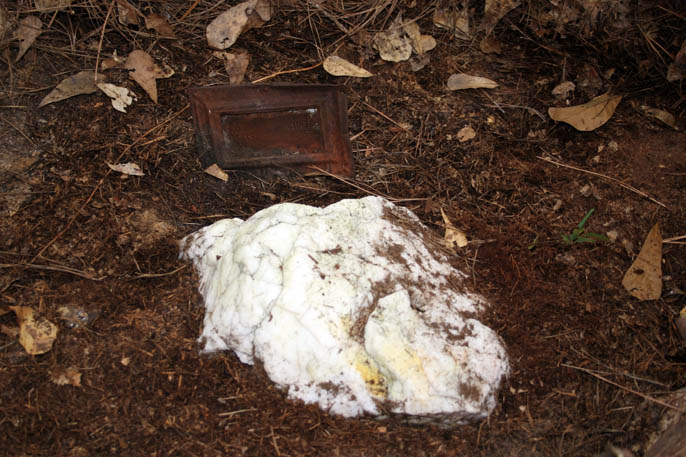
This could be the grave of either James Clyde Trexler, Lena Trexler, John Henry Trexler or
Mary Mollie Moore Trexler and in all probability, all four are buried here
with unmarked graves since there are several quartz stones used as grave
markers outside the wrought iron fence. Grandma Coley told Aunt Mollie
Bowers and Sis Ackerman that family members were buried there but did not
mention any specific names which is very sad indeed. We do know that
Grandma Coley's Grandmother is buried there inside the wrought iron fence
who was the first wife of James Rex Moore and later property transfers from
the James Rex Moore Estate to the children of Mary Mollie Moore, Grandma
Coley's Mother validates this as detailed several paragraphs above with
specific deed references.
MOSES THOMAS TREXLER
I found the Certificate and Record of
Death of
Moses Thomas Trexler, (second page of
document) Grandma Coleys older
brother who died on March 18, 1960. I don't remember anything about
Moses Trexler at all. I only remember visiting Callie and Zeb
Hanna who had a farm out 109S, Jones Road in the vicinity of the Hanna Chapel and
Charlotte "Aunt Sis" Tarlton who lived on Capel Dairy Road, whereas her
husband died in 1936 and her Daughter Thelma Tarlton James lives in the old
home place at the present time.
I visited the Hanna Chapel United Methodist Cemetery on 08-16-15 and located
the graves
of Moses T. Trexler and his second wife Warren Hines Moses, whereas she died in 1958.
The grave
of his first Wife Mollie Huneycutt was located, whereas she was born on
February 12, 1884 and died on May 20. 1922. Moses and Warren had
an infant daughter that
died on June 27th and will have to go back
and remove dirt from the base of the stone to ascertain the year. They
also had twin sons that
died on May 25, 1925.
Aunt Mollie Bowers related to me that Moses lived on Old Lilesville Road
here in Wadesboro and while viewing deeds at the Anson County Register of
Deeds Office, I located a land transfer consisting of 4 lots from J. W.
Sullivan who had sub-divided his farm. Moses later deeded 2 of the lots to
his son Donald by his second wife and 2 lots to John T. and Georgia Russell his
daughter by his first wife. I have the deeds and plat information in
one document hyperlinked
here. Georgia Trexler Russell was born on June 27,
1910 and died July 3, 1998 and
buried in the Anson Memorial Cemetery Park
with her husband.
ELLIS THOMAS TREXLER
I located a copy of the Marriage License of Grandma Coley's Brother
Ellis Thomas Trexler who born on April 21, 1900 and married Mamie Eddins on August 17, 1919 on the bank of
river in Lilesville Township. I observed that he referred to his
mother as Mollie Trexler on the
marriage license of which she and his
Father John H. Trexler were dead. On 08-11-15, I found additional
information about Ellis Trexler, whereas he lived in Greensboro, Guilford
County, NC and was a dispatcher at an Oil Terminal. He died on January 21, 1945 being
only 44 years old and buried in the
Guildford Memorial Park. I have that information hyperlinked
here.
His wife Mamie Eddins Trexler was born on October 31, 1899 and died on July
3, 1974. She died in Broward County, Florida and is
buried in the Guildford Memorial Park,
Greensboro, NC.
They had one daughter, Sara Trexler Melvin born Sep. 23, 1925 and died Sep.
8, 1998 and
buried in the Guilford Memorial Park,
Greensboro, NC. I wrote the Register of Deeds in Guilford County,
Greensboro, NC on 08-16-15 requesting a copy of the Certificate and Record
of Death of Ellis Thomas Trexler to ascertain what the cause of his death
was attributed to since he died fairly young.
I received a copy of his
Certificate Of Death on 08-21-15, whereas
he died from secondary anemia due to hemorrhage from bowel due to
Laennec Cirrhosis of Liver and had the
condition 3 to 4 weeks. He had an accident 5 or 6 weeks prior but no
connection at autopsy. Aunt Mollie Bowers said Ellis didn't drink,
therefore according to the experts, children of malnutrition with a protein
deficiency usually develop the disease later on in life, especially men
between the ages of 40 to 60.
JOHN H. TREXLER, JR. AKA JOHN BRAXTON TREXLER
John H. Trexler, Jr.
married Ollie Faulkner on May 24, 1908 and was 21 years
old, whereas Ollie was the daughter of James C. "Jim" Faulkner, Sr. and his
wife was Heny Catherine Faulkner, both buried in the Eastview Cemetery here
in Wadesboro. Remember, James C. "Jim" Faulkner, Jr. is the
biological Father of Joseph Julian Coley and my Grandma "Della" Trexler
Coley being the Mother. According to Aunt Mollie Bowers, John
Trexler, Jr. of who she referred to as "Uncle
Johnny" was married twice and he was a lineman for the
telephone company in Charlotte, NC and was injured while on the job.
UNCLE JOHNNY BEER AND SNUFF CAN EPISODE
Aunt Mollie remembers one incident that happened during one of Uncle Johnny
and Aunt Lillie's visits sometime around 1947 when she was pregnant with her
first child June. They would use the front and/or side porch at
Grandmas house which had several rocking chairs and one of them had a broken
back on it, Uncle Johnny had just consumed a beer and was getting his
snuff can out and told one of those present that he would offer them a beer but he
heard he could not hold his beer. At about the same time he was getting
ready to pour a dip of snuff between his gums and lower lip, he leaned back
in the rocking chair and it flipped him over backwards with the fine powered
dark colored snuff going all over himself. Aunt Mollie said the entire
crowd that was present broke out into a loud laughter and about tore a gut out from laughing so hard and one
of them said to Uncle Johnny, "I believe you are
the one who can't hold their beer."
I plan to do some additional searching and see if I can locate a copy of
his Certificate of Death.
On 08-16-15 while doing some internet searching, I found one
record that lists John Braxton Trexler born
in Anson County with his father, John Henry Trexler; mother, Mollie Moore and
spouse Lillie Ramsey Trexler which that information is right on the money. He lived in
Charlotte, NC and was an Electrician whereas Aunt Mollie said he worked for
the Telephone Company; pretty close there too. His year of birth was
1887 and according to his first marriage license he was 21 in 1908 of which
this information is correct too. "Uncle
Johnny" as Aunt Mollie called him, is buried in the Oaklawn Cemetery in Charlotte, NC
and hyperlinked
here. John and Lillie Ramsey Trexler
did not have any children. I received a copy of his
Certificate Of Death record from the
Mecklenburg County Health Department on 08-29-15 and they have his name as
John Braxton Trexler and died on June 2, 1959 from
carcinoma prostate and had the condition
for 2 years.
SINGLETON SILK MILL DRAWING AND INFORMATION
Below is a hand line drawing of the Singleton Silk Mill received from TD Burns on
06-15-15. There is a photograph in Mary Medley's book
History of Anson County 1750 - 1976 of the
Singleton Silk Mill but it is very poor quality of which I plan to get a
copy of the picture in the future. This sketch was made by James D.
Lewis in 1976 of which I also got a copy from Risden Hill on 06-17-15.
You can barely make out the Lewis signature in the lower right hand corner
of the pix of which I replaced TD Burns copy with the copy received from
Risden Hill. James D. Lewis apparently made his drawing from memory
because the details as far as the end of the building, etc. do not match the
1900 photograph and still not a bad drawing from memory either.
I will check Ms. Mary Medleys book again and see how close the drawing is in
comparison to the 1900 photograph taken.
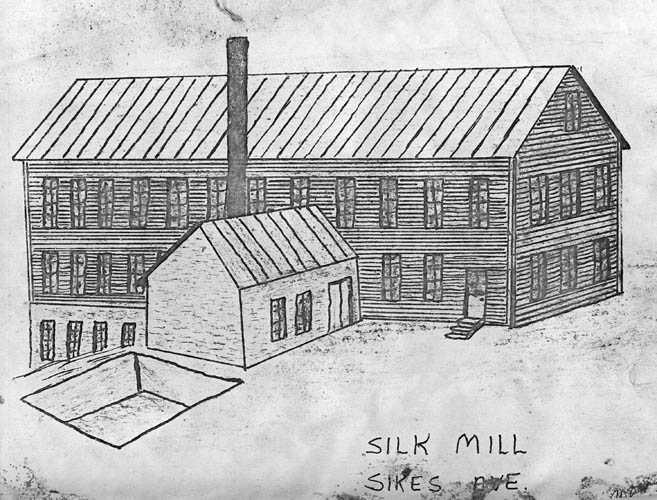
OIL PAINTING BELOW BY IRIS TEFF, BADEN LAKE, NC

Above oil painting I commissioned Iris Teff of Baden Lake, NC to do based on
two photographs of the Singleton Silk Mill and the line drawing by J.
D. Lewis in 1976.
SINGLETON SILK MILL PHOTOGRAPH CIRCA MAY 1900
Below is an actual picture taken by Professor Charles A. Young, Astronomer of Princeton
University while doing Research on the
Solar Eclipse of May 28, 1900.
Mark Treadaway located the picture while doing his own solar eclipse research of the old
archives at Princeton University and my Sister Susan Pettigrew copied the picture from his Facebook page
and emailed it to me and I certainly do
thank Mark Treadaway for posting the picture and also for donating a hard copy to the Anson
County Library genealogy room. The picture angle in my humble opinion doesn't give the
true height perception of the ole Silk Mill as I remember it since the photograph was taken a
good distance downhill with a predominant foreground from the Silk Mill, but
then again, when we are younger things have a different visual perspective too!
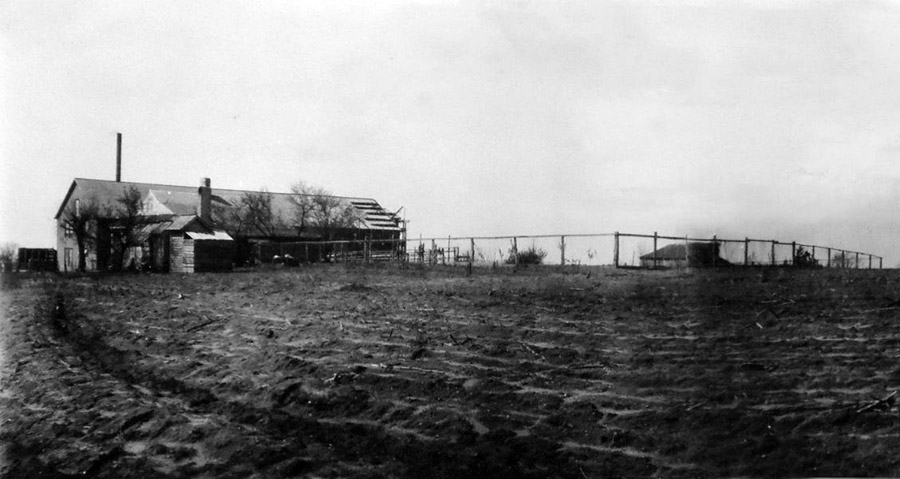
Below is a pix that Dianne Welch scanned and emailed me from the photograph
that Mark Treadaway donated to the Anson County Library which is cropped
different and shows more hue and detail. It appears the rectangular
building in front of the larger building has some type of construction going
on by the presence of a boom on the far right side of the building and they
might be in the process of finish putting tin on the roof as evidenced by
the horizontal layers with open spaces between them which is typical of tin
roof construction; just a "guess at the best":
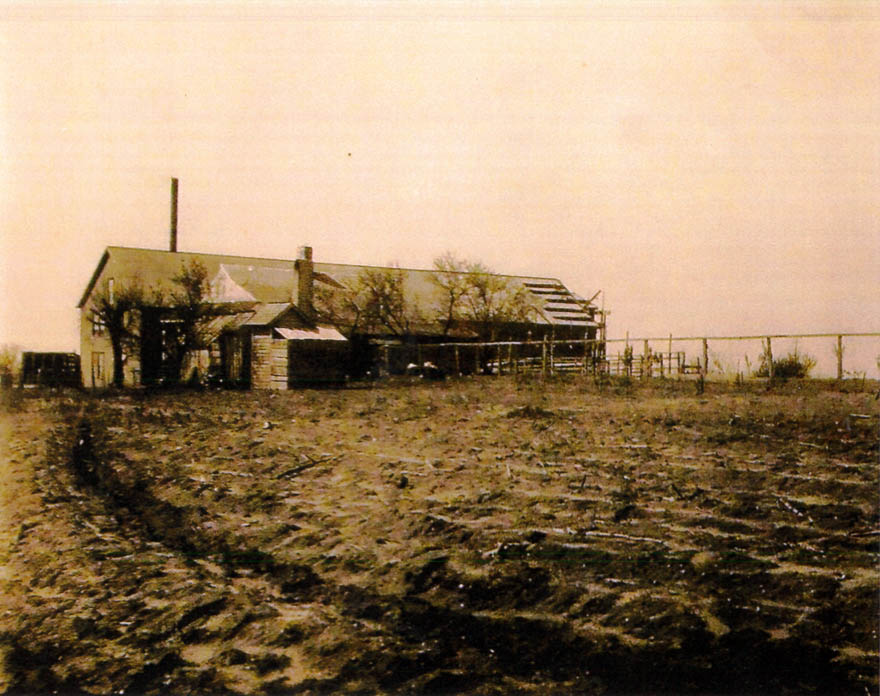
When myself, Cousin Johnny Ray Coley (deceased) and my brother Allen Porter
were sneaking into the unlocked building back in the middle to late 1950s and through
the middle 1960s until it was later destroyed by fire, the area wasn't
as open as in this picture. It appears that the area was freshly
plowed up to the fence line and looks like the remnants of corn stalks in
the plowed area. There is a good elevation drop depicted in the
picture from where the camera was set up to the
fence line and the only area I remember close to the Silk Mill with the above
elevation drop where the Silk Mill stood in the 1960s was facing toward
Maple Lane on the edge of the Silk Mill property. The woods back then was grown up nearly to the edge
of the building on the left and there were large trees on the above property
and no fence either. There was at least one
Catalpa aka Indian Cigar Tree on the property and I remember the
long seed pods that would hang down and eventually dry out and burst open. Young folks wanting to try their hand
at smoking, would try and smoke the dried out pods and also
smoke
rabbit tobacco in home made acorn
pipes.....grin if you must! For some reason, I don't remember the front
facade of the structure of the building and it appears there is a building
in front of the main structure but that was over fifty-five (55) years ago. The driveway coming off Sikes Avenue going up the
incline to the Silk Mill was also
about overgrown, especially on each side of the driveway but still passable with a vehicle and a smaller building was
located on the right hand side of the driveway and a larger building further
up the driveway if memory is correct which might have been the home of the Superintend and/or the
persons running the mill. The Stations lived in that house at one time
per Aunt Mollie Bowers and others. There were several large Walnut trees near
the old mill and this picture sure does bring back some wonderful memories
from the past. It was an amazing sight to a young kid being on
the upper level of the ole Singleton Silk Mill looking out over the
countryside taking in such a wonderful panoramic scenic view. Above photograph added on August 13, 2015.
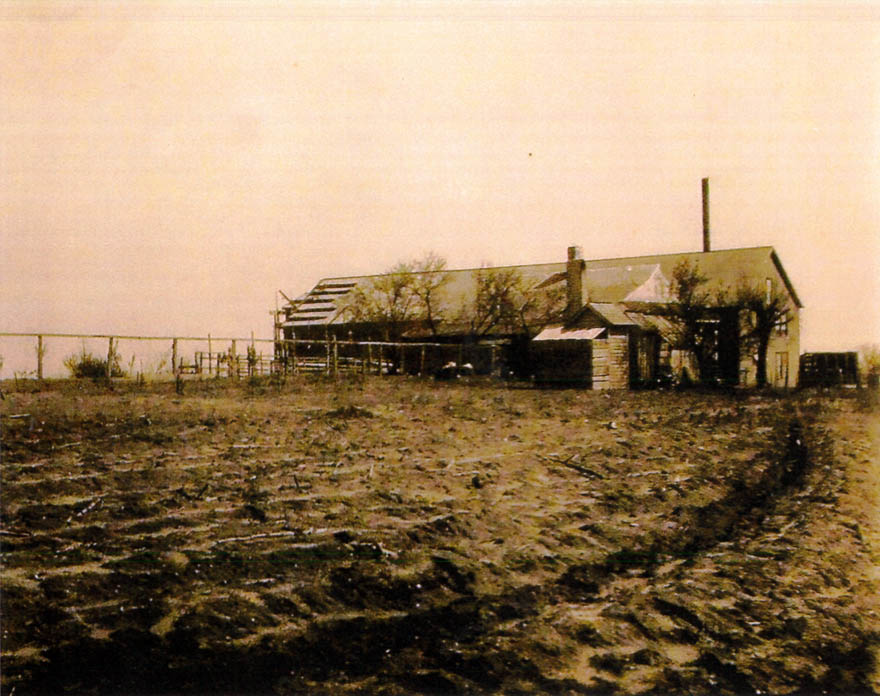
I flipped the picture horizontally and it matches the line drawing and Mary
Medley's picture more closely. I believe the negative glass to capture
the above picture was flipped when they made a print from it, in
my humble opinion.
COMMENTS MADE BEFORE RECEIVING THE 1900 PHOTO ON
08-13-15
If memory is correct, the west end of the building to the left had some type
of inside stairwell that went up to the top floor and we could look out over
the countryside. The in ground depression in front of the small
building (drawing) was a concrete and/or brick lined water reservoir which
was in the edge of the woods in the 1960s and covered with vines, etc., and still
had a metal roof over it. There were some piping that went
toward Maple Lane and there was a reservoir not too far off the road of
which it appeared they might have pumped water from it to the Silk Mill
in my humble opinion. It also had a metal cover over it and was always
filled with water; it could have been a hand dug well also. For some reason, I don't remember the small
building attached to the side/front of the mill or the smoke stack,
therefore it torn down and removed prior to the middle to late 1950s as I remember the
mill. I am not exactly sure of the orientation of the mill as its
location in relationship to Sikes Avenue at the crest of the hill. At
the time of this mill in 1888, they would have used steam power and that
smaller attached building could have been their original power plant as
evidenced by the smoke stack. Many old mills of this type had one long
power shaft that went the entire length of the mill supported on bearings and leather drive belts
were fastened together at their ends with flat metal rings or hooks where
they could be installed onto the main drive power shaft going to each bank
of machines. Imagine what kind of noise that would generate with all
those leather drive belts making that plop, plop type sound ever time the
belt made a complete revolution with the metal flat rings making contact
with the power drive shaft and the machine drive pulley and that was long
before
OSHA.
Below pix from Mary Medley's book
The History of Anson County 1750 - 1976
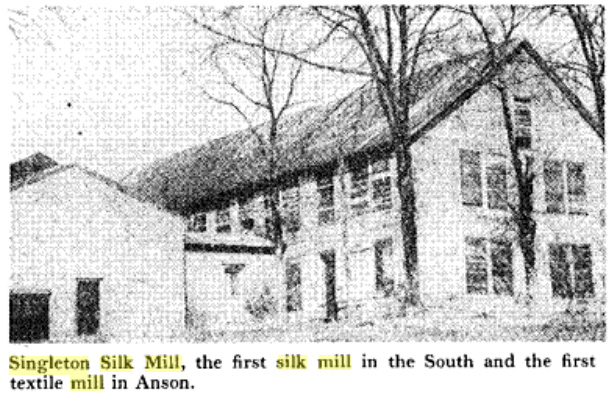
The above pix gives a more realistic visual as to the size of the structure
from ground level. As I stated earlier about the pixs posted on here,
I only remember one long rectangular building with no other structures
attached or near it in the middle to late 1950s through the mid 1960s.
SATELLITE IMAGE OF THE AREA TAKEN IN 2012
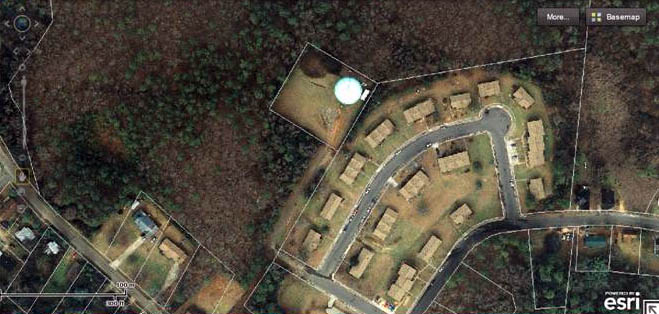
I am guessing that the Singleton Silk Mill was located somewhere near the
south east side of the water tank of which the terrain was then sloping downhill on the left hand side as per the
1900 photograph was taken and the building would be facing more parallel or
at an angle toward Sikes
Avenue. In the above satellite image; If you travel West from the
water tank you will end up behind Grandma Coley's old home place at 910
Maple Lane. Toward the end of this short story, there is a picture of
Grandma Coley and Cecil Ackerman standing near the right front portion of
the
home of Grandma Coley and off in the background you can see the
water tank that was constructed in 1968 to 1969 after the demise of the silk
mill. However, the angle of the camera lens compresses the background
in the picture making it look much closer than it actually is and also by
the size of the water tank itself. The
old driveway/road going to the Singleton Silk Mill in the 1960s was right at
the crest of the hill at the beginning of the curve in the road of Sikes Avenue in the above pix. I plan to walk that area in the near
future when the temperature cools down some and see if there is anything recognizable around the perimeter of the
current landscape.
I walked directly by the Singleton Silk Mill during the middle to late 1950s through
1964 as my short cut from Wadesboro Middle School on White Store Road and
the Wadesboro High School on Camden Road, whereas I crossed highway 74 and went down
N. Rutherford Street of which it is a steep uphill climb and crossing
Wheeler Street. I then went by the smaller City water storage tank going
onto the property of Daisy Bell Wheeler and her Mother and there was a well
worn trail through the woods that came out right below the crest of the hill
there on Sikes Avenue. I then climbed the red clay bank and/or went
up Sikes Avenue to the left (depending on the weather) about 20 yards and accessed the
old driveway toward the Silk Mill. The flat open area had several
large Walnut trees and an Indian Cigar Tree and the rest was grown over with
broom straw
until you reached the back side of the property which had various types of
pine trees and hard wood trees growing. It
didn't take too long going down the back side of the property which was all
down hill until I reached the small branch behind our home and then it was a
short up hill walk to our back yard at 910 Maple Lane. I am surprised
that my memory has failed me on the exact orientation of the Silk Mill but memory
has a way of doing that many decades later.
Aunt Mollie Bowers related to me that as a young teenager she remembers
climbing up the stairwell (circular stairs) to the top floor and she could
look out and see their home directly in front of the end which would make
the orientation of the mill with the long side more parallel toward Sikes
Avenue than with the end facing Sikes Avenue. Check this 1940
image
of a map layout of Wadesboro which shows the orientation of the Silk Mill
(A) in relationship to Sikes Avenue and the West Side Extension land (D)
owned by Jesse McKnight "Mack" Coley. UPDATED: 08-22-15.
Aunt Mollie also remembers the reservoir near the silk mill and the one
adjacent Maple Lane and stated they later covered it over with a tin roof of
which that is what I remember for both of the reservoirs. I do not
remember any well located on the silk mill property and Aunt Mollie said
they pumped water from the reservoir off Maple Lane and remembers the pipes
going up the hill to where the silk mill was located. She said there
was a well worn path going from the reservoir to the plateau where the
Singleton Silk Mill was located and definitely used since I doubt any of the
laborers owned a vehicle at that time.
MS. SALLY R. SMITH, GRANDDAUGHTER OF CHARLES UREN
While doing further research at the Hampton B. Allen Library in Wadesboro,
NC on August 17, 2015, I found pictures in the Singleton Silk Mill
file kept in the genealogy room that Ms. Sally R. Smith of Berlin, MD
submitted to the library via Steve Bailey back in 2011. I wrote Ms.
Smith a letter and asked for additional information concerning the pictures
and she emailed me back on 08-22-15 whereas, "When Mr. Singleton visited
Rose Hill (location of the mill), he brought his own bed and wash stand for
comfort. When the mill closed, he left these items. I have his bed and
my daughter has his wash stand. As I understood it, Mr. Singleton
didn’t live at the mill house but when he came down from N.J. he would stay
at the house because he felt more comfortable there instead of the boarding
house." Ms. Sally R. Smith is the granddaughter of
Charles Uren who
replaced Robert Singleton after 1905 as the new Superintendent of the Singleton
Silk Mill and he stayed there until the mill closed in 1927. Ms. Smith
is going to take digital images of the items mentioned and other artifacts
from the Singleton Silk Mill and send digital images of them to me when time permits.
View this
clip of how silk is made.
Aunt Mollie Bowers remembered the name Charles Uren when I last talked with
her and she stated that Grandma Coley personally knew
Charles Uren as he
would come through the mill doing inspections. Grandma Coley worked at
the mill from 1902 until she married Jesse McKnight "Mack" Coley on August
21, 1919 except for a couple years when they enforced the
Child Labor Law.
JIM FAULKNER AND DELLA MARRIAGE APRIL 12, 1912
Mary Frances "Della" Trexler was working at the
Singleton Silk Mill when she married James C. "Jim" Faulkner, Jr.
on April 12, 1912 at the home of her Father John H. Trexler. The
marriage license list her name as Della
Mary Fanny Trexler with her Mother Mary Moore Trexler being dead. They had a son,
whereas Joseph Julian "Joe" Faulkner was born on September 5, 1912.
From information gathered, there was some type of continuous serious verbal
conflict and feud between Jim Faulkner's Mother and Mary Frances aka Della, her son
Jim Faulkner and the Trexler family over the marriage, whereas Jim Faulkner
enlisted in the US Army around 1914; (I call
this abandon ship) and was transferred to China for duty and
after a lengthy Military career, retired from the US Army. He
eventually resided in a VA hospital in California and never returned back to
Wadesboro to even visit his own Mother and family here in Wadesboro, let
alone visit his son and wife! I have not been able to ascertain what
prompted Grandma Coley to write Jim Faulkner after all those decades and if
she related that to me, it has long been forgotten. Apparently, she
heard of Jim's illness at the time from some of the Faulkner relatives but
this is just a guess since Jim was staying at the VA Hospital at that time.
Sometime around 1957, Grandma got Jim Faulkner's address from his local
relatives and had someone in the Faulkner family write him a letter on her
behalf while Jim Faulkner was in the Veterans Hospital in California.
Jim Faulkner wrote her back expressing how sorry he was for what he had
done. He also stated that he had had a good life and hoped that she
had too. They never corresponded again. This is a fact as my
Aunt Mollie Bowers read the letter received from Jim Faulkner of which she
(Mollie) was very upset at the time after reading the letter. One of
our relatives visited Jim Faulkner sometime around 1958 while he was living
in the VA hospital in California with serious health issues where he later
died there. I know the above info is out of chronological sequence
throughout this entire short story and I keep rambling back and forth in
time; hopefully it will make some kind of sense.
Jim Faulkner's Dad,
James C. Faulkner, Sr. and his wife are buried in the Eastview
Cemetery here in Wadesboro, whereas James C. Faulkner, Sr. was born on
November 24, 1859 and died February 15, 1921 and his wife
Heny Catherine
Faulkner was born on August 7, 1864 and died on July 7, 1945.
GOITER SURGERY
Grandma Coley during her early teens had learned to play the piano and organ
by ear and would play for several of the local churches, camp meetings, etc.
Aunt Mollie Bowers remembers Grandma telling her that she use to play the
organ at one of the outdoor Brush Arbor meetings that was sponsored by the
Methodist Churches and it was held near the ole
Seago Cemetery.
The area in front of the Sego Cemetery is now occupied by The North
Wadesboro Baptist Church at 1211 N Green Street, Wadesboro, NC. It was
during one of the
Brush Arbor meetings that Mrs. Mary Austin Bennett Little,
a very prominent Wadesboro community woman and leader took an interest in Grandma recognizing her talent
and no doubt her poverty,
etc. A few
years later sometime around 1914, Grandma developed an enlarged goiter on
the front of her neck and this was the time her son Joseph Julian "Joe"
Faulkner was around two (2) years old. Mrs. Mary Austin Bennett Little provided
Grandma with a passenger train ticket to the
John Hopkins Medical Facility in Baltimore,
Md. to have
goiter surgery which would have been a very
expensive procedure in 1914. NOTE: According to Elizabeth
Coley Ackerman's account, Grandma had the surgery in Charlotte, NC. The surgery was successful and Mrs. Mary
Austin Bennett Little was a family friend the rest of her life to Grandma Coley and her
family. Mrs. Mary
Austin Bennett Little
helped many individuals in her lifetime with her resources and she was born in
1866, died in
1956 and buried in the Little/Bennett family fenced in cemetery at the
junction of Highway 74 and Anson High School Road adjacent the school
property.
Another Wadesboro prominent woman Ms. Susan Hardison and her husband Herman
Henry Hardison provided music and voice lessons for the Coley girls which
used their God given talents to enrich the lives of many others. Ms.
Hardison's ground keepers name was Buck and their maids name was
Trotty...don't remember their last names but I do remember Buck since he
maintained their estate which was located between Martin Street, S.
Rutherford Street and Highway 74E which is now occupied by a bank and later
by KFC.
JESSE AND DELLA MARRIAGE AUGUST 21, 1919
"Della" would deliver pies to the
boarding house to earn extra money of which the boarding house was owned and
operated by Ab and Jean Jordan according to Aunt Mollie Bowers
as was told to her. One day while delivering home made
pies to the boarding house, Jesse McKnight "Mack" Coley was sitting at the
table and noticed Della as she entered and he opened the door for her and as
she was leaving touching her hand. Mr. Coley related to their children
later in life,
"That she was the prettiest woman he had ever
seen." I can certainly relate to such an event as I can
remember the first time I saw my bride to be in 1957 when I was eleven (11)
years old and remember the color of her dress and details about how she
looked, etc. None of the deed documents supports this since Ab and
Jean Jordan purchased the house at 1000 Maple Lane in 1919 from The Anson
Real Estate and Insurance Company who owned the house for 4 years, purchased
it direct from George Singleton of the Singleton Silk Mill. The house
at 910 Maple Lane was also owned by the Anson Real Estate and Insurance
Company and Mr. Coley purchased it in 1921 after Grandma Coley and he were
married on August 21, 1919. He purchased the Seaboard Hotel aka J. M.
Coley Hotel on December 27, 1919 after they were married of which all the
documents are hyperlinked at various places. I believe Elizabeth Coley
Ackerman's account in her Original Story
is more in line with the deed documents, whereas she stated Grandma and Mr.
Coley lived in the Seaboard Hotel for 2 1/2 years. Later during my
research, I found that Mr. Coley purchased a
house on Wheeler Street on September 19,
1919 the following month after they were married also providing a house for
them to live in and/or use as a rental property. This is an example of
where memory fails over time without accurate documentation.
Jesse McKnight "Mack" Coley
married "Della" on August 21, 1919 at the
Singleton Silk Mill with the ceremony performed by Edward Stogner, Justice
of Peace. Mr. Coley later adopted her 7 year old son Joseph Julian
Faulkner and had his name changed to Coley. Mr. Coley purchased a house
on Wheeler Street on September 19, 1919 per Deed Book 57 Page 354 referenced
above with a hyperlink to a copy of the deed. Mr. Coley purchased a
boarding house referred to as the
Seaboard Hotel and/or
J. M. Coley Hotel on Dec. 27, 1919.
Aunt Elizabeth "Sis" Ackerman stated in her
Original Story
in 1999 that her Mom and Dad lived at the boarding house for 2 1/2 years.
Mr. Coley purchased a sizeable amount of
property referenced above which included a (boarding house,
according to Aunt Mollie Bowers) at 910 Maple Lane from The Anson Real
Estate & Insurance Company on March 9, 1921 who was selling off properties
that were previously owned by George Singleton of the Singleton Silk Mill with property
plat as the
West Side Extension, apparently due to a decline in the silk business.
The July 1915 plat listed in
plat book 1, page 37 does not show a
structure on lot No. one (1) block G which is now 910 Maple Lane today,
however the home was definitely there in 1921 because that is where all the
Coley children were born starting with Elizabeth "Sis" on May 25, 1921,
followed by Mack, Jr., Doug, Mollie and Ann. Mr. Coley
purchased the home at 1000 Maple Lane where the Trexler family
was living from the
Jordans on April 14, 1930. To recap, Grandma "Della" and Jesse Mack Coley had
two sons;
Jesse Mack, Jr.,
Douglas Ross and three daughters;
Elizabeth,
Mollie and
Ann. Elizabeth
was the oldest and was born May 25, 1921 and the children were spaced about
18 months or so apart with Ann being the youngest. Jesse "Mack" Coley
was 31 years older than Della and they both ran a small Dairy farm
delivering bottled milk to the families of small babies and butter throughout the Wadesboro community delivering
their goods by horse and buggy. Other families would come by the home
place and purchase the milk and butter. Mr. Coley taught Della to read and
write since she had no formal schooling. I remember hearing stories
from Uncle Doug of how they tended the cows that grazed on the Coley land
and adjacent land owned by Dr. Carl Lawson. That same land consisting
of several hundred acres or more in several large tracts is not commercially
developed today; owned by Shirley Lawson Ratliff of Jacksonville, Al.,
Dunlap & Mills, Mariette & Wm. Huntley of Wadesboro, NC and basically
appears about the same except for the harvest and replanting of pine trees.
I hunted on that land as early as 1957 when I was 11 years old and there
were huge diameter saw timber pines on it and the remnants of rotted out
stump holes where much earlier trees were harvested. I remember the
large pines mentioned above were harvested before 1964 and the beautiful
scenery certainly was changed but does recover in time from logging if not
totally clear cut in my humble opinion.
SEABOARD HOTEL INFORMATION
To reiterate,
Mr. Coley after his marriage to Mary Frances "Della" Trexler on April 21,
1919, he purchased a two story boarding house which some refer to as The
Seaboard Hotel near the Wadesboro Train Depot on December 27,
1919 from W. F. Causey and Rosa Causey, of Union County for thirteen hundred
and seventy-five dollars ($ 1375.00), whereas the Hotel was mostly occupied
by traveling railroad workers, therefore earning the name
Seaboard Hotel. W. F. Causey and his wife Rosa Causey
purchased Lot No. 1 Block 12 on Feb. 20, 1916 as shown in
Plat Book 1, Page 10 which is on the
original land plat by John T. Patrick and survey done by A. F. Lyman, C. E.
Grandma Coley related how she worked there helping run the place; washing
the bed linen and hanging out the laundry in all types of weather, cleaning
all the smoky globes on the kerosene oil lanterns, etc. Mr. Coley also
purchased lots adjacent to the Hotel from C. R. Lawson and his wife, Lucy E.
Lawson on April 30, 1927. Lot No. 1, Block 12 which was the Hotel lot
was sold to Henry H. Stafford and his wife Sara Frances Stafford on July 23,
1947 after the death of J. Mack Coley by the Coley Heirs. I talked
with several people that remember the ole boarding house aka Hotel and plan
to search for the "remnants" of it, since it is long gone. I
have a .pdf file that details the purchase and sale of the
Hotel property from copies of the deeds and plat of said
property. I haven't been able to ascertain yet, how the ultimate
demise of the Hotel came about but there was a rash of arson files that
destroyed many old abandoned buildings in and around the Wadesboro area.
I talked with Risden Hill, local historian this evening on 06-17-15 about
the hotel and he emailed a sketch/drawing of the Seaboard Hotel done by
James D. Lewis in 1976. I don't know what photograph Mr. Lewis used as
a reference source to complete the drawing and since the structure was not
there in 1976, whereas Mr. Lewis did a series of about 10 line drawings of
historic places here in the area that were also gone. Risden Hill,
local historian thinks James D. Lewis drew the line drawings from memory. Below is the
line drawing:
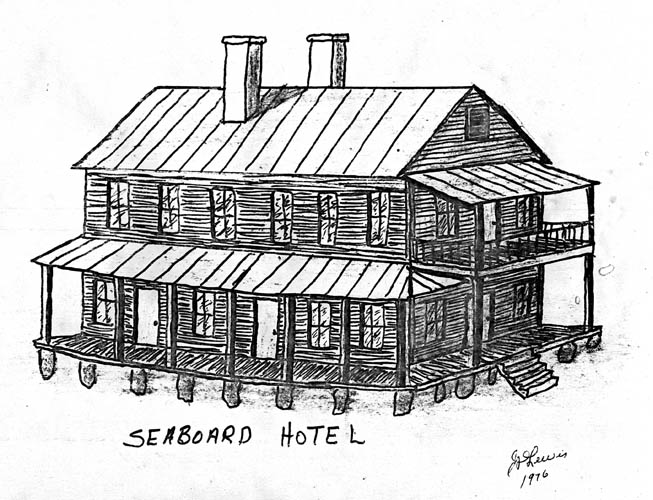
I walked through the area mentioned above on 06-18-15 where the hotel would
have been located and could only find foundation pillars and a part of a
chimney that was made from brick and mortar, whereas the length of
foundation pillars of one side of the ole structure was approximately 36
feet long equally spaced apart of one side of a structure. From those
that remember the ole Hotel, the right hand end of the building with the
second story "porch" was facing the railroad tracks. I certainly would
like to find a photograph of it.
I talked with Julie Jenkins who is the Grand Daughter of Henry H. Stafford and
met with her husband Lee Jenkins on 07-23-15 near the Depot and he showed me
where the remains of the old Hotel is located and it was the same area that
I had located earlier. Below is a pix of some of the foundation
pillars and the only remains left of the hotel:
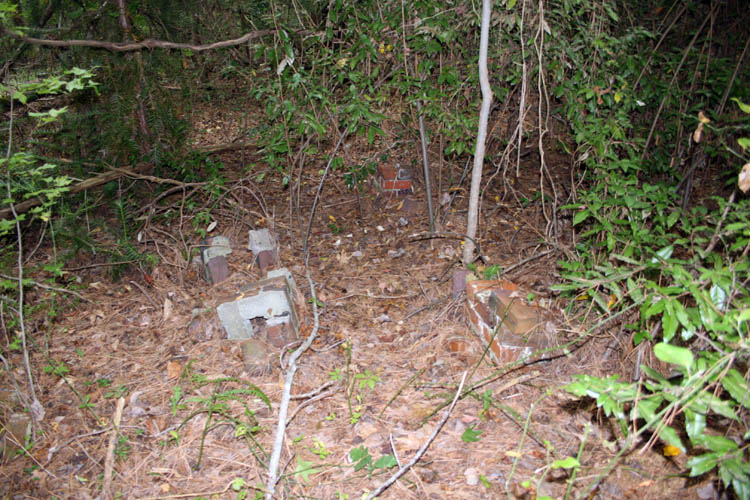
Lee Jenkins stated that sometime in 1971 while Henry Stafford was still
living in the ole Hotel, he observed smoke coming from the building from his
house on Liberty Street and ran down to see if Henry Stafford was in the
house and as he entered the first floor, the upper story was in flames and
leaking burning pitch from the ceiling from the heart pine timbers used in
the hotels construction. Henry wasn't in the building at the time and
a train was on the railroad tracks blocking access to the home and the fire
truck had to go around coming from off North Green Street and by then the
structure was totally engulfed in flames. Lee Jenkins said that Henry
Stafford lost everything he owned in the fire.
Lee Jenkins showed me a picture of Henry Stafford and his wife standing near
the front porch of the Hotel and plans to get me a copy of it, however you
can't see much detail about the hotel due to the close in angle of the
camera. When Lee and myself exited the area and crossed the railroad
tracks a train was approaching and I took a pix which shows the relationship
of where the ole Hotel was located at in relationship to the distance from
where the Depot aka Train Station was located which is also long gone.
Pix below:
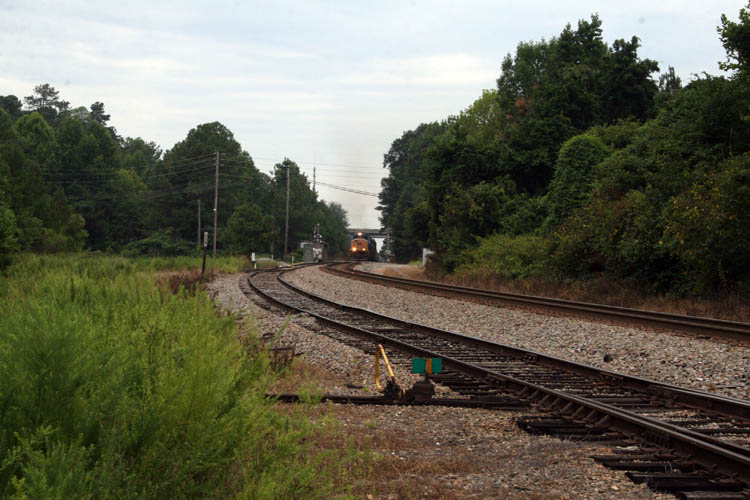
The ole Hotel was more or less directly in front of the area where used
railroad crossties are currently stored. If one would make a ninety
degree turn to the right in the above picture, you would be facing the front
of the old Hotel property.
During the late 1950s and early 1960s, I walked right past the front of the
ole hotel using the railroad tracks and never paid any attention or observed
the ole hotel while in route to the ole V. C. Fertilizer Plant where I
hunted small game. The building possibly was obscured by trees and/or
bushes concealing its view from the railroad tracks and if I did observe the
building, it sure didn't stick in my brain! The ole Seaboard Hotel
according to the plat would have been at least 100 feet from the railroad
right of way. If Tim Boone will let me have some of the foundation
pillar bricks, I will take a tape and measure the distance from the side of
the railroad tracks just for my own curiosity.
Below is a pix of the Wadesboro Depot in 1972:
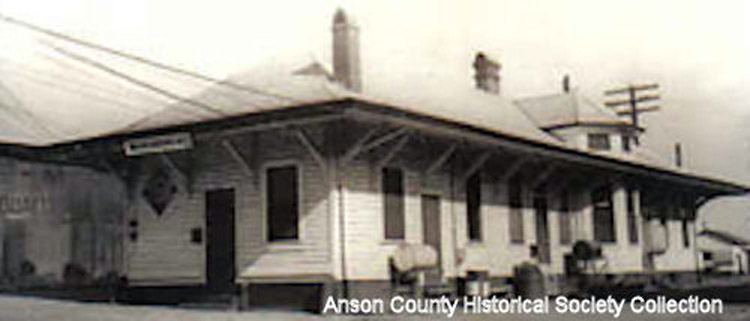
I did find one
deed dated April 30, 1927 that referenced
the Third Lot Mr. Coley purchased on this deed as follows: THIRD
LOT: Beginning at the Northeast corner of the
J. M. Coley Hotel lot being lot No. 1 Block 12. I obtained
copy of the
John T. Patrick Depot Land in Plat Book 1, Page 10
which shows the lots per the deed transfer. Mr. Coley already owned
Lot 1, Bock 12 which was the location of the Seaboard aka J. M. Coley Hotel
when he purchased those additional and adjacent lots. This
document details the history of the Hotel lot of which
Timothy Boone is the current owner of Lot No. 1 Block 12.
Lots 29 and 30 Block 12 were sold to
Albert Baxter Bowers, Jr. aka "Buddy" on December 1, 1989 by the remaining
Coley Heirs. I did not track down the sale of the land on Plat 2 and
Plat 4 shown on the
J. M. Coley Heirs Plat done in 1970 or one
of the Graham Street properties which were sold prior to 1970.
Risden Hill sent me a copy of a newspaper article published in the Anson
Record on Tuesday, April 13, 1971, whereas the paper called it the Old
Terminal Hotel, of which was destroyed by fire on March 16, 1971,
hyperlinked
here in .PDF format. Updated
by Bill aka Mickey Porter on 06-27-17.
JOSEPH JULIAN "JOE" COLEY ADDITIONAL INFORMATION
My Uncle
Douglas Ross Coley related to me how much
of a physical man Joe Coley was and stated that Joe could hold both arms out
by his side and parallel to the ground and he and his brother
Mack (WHS Class of 1940) could
"skin the cat" on them at the same time;
remember we are talking about small boys probably ten years old or less at
the time, especially Uncle Doug. That would still require a
tremendous amount of strength to accomplish of which the average or far
above average person would not be able to do. Doug said that Joe could
lift a 200 pound sack of grain with one hand/arm which is a super strong
feat for sure.
Below is a "picture of a picture"
of Joseph Julian Coley that I took on 06-15-15 of which his Daughter Mary
Helen Dutton (WHS
Class of 1951) allowed me to photograph. The original picture has
degraded much over the decades since the picture was taken sometime in the
early 1930s, whereas Joe died on August 25, 1934. The picture
certainly reveals the Coley profile and the broad shoulders. Everyone
that remembers Joe Coley talked about his physical size and strength.
He sure does have the "Della" Trexler look to him from Grandmas side of the
family as well. I ran the pix through PhotoShop CS2 and did the best I
could with it:
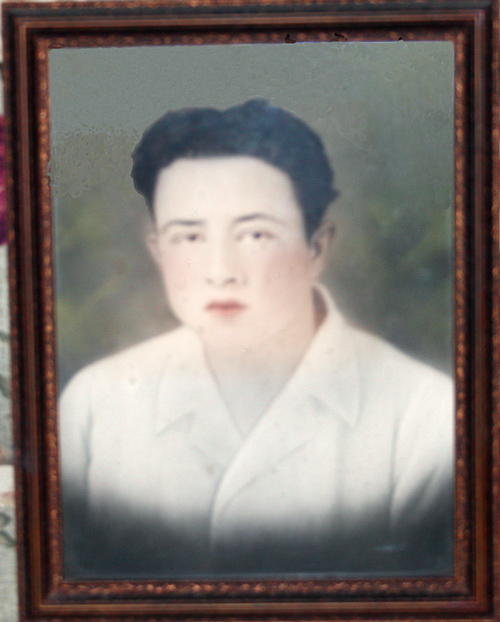
Joseph Jullian "Joe" Coley married Virginia Mowery and they had one daughter
Mary Helen (WHS
Class of 1951). Joe was killed resulting from a car accident on August
25, 1934 near the Old West Knitting Mill which is now part of the South
Piedmont Community College, whereas the automobile plunged down into a
15-foot deep ravine/culvert at the intersection of Mimosa Terrance and N.
Washington Street.
Joe and Virginia Mowery Coley were living in the two story boarding house
aka Seaboard Hotel near the Wadesboro
Depot that Grandpa Jesse McKnight "Mack" Coley owned and Joe worked for the
Wade Manufacturing Company until his untimely death. Mary Helen Coley
Dutton related that information to me about Joe and her Mother living at the
Seaboard Hotel and Grandma Coley was looking after Mary Helen at 910 Maple
Lane while Joe and Virginia were working and she said the first thing that
Joe did when he came in was to pick her up and kiss her as was related to
her from her Mother years later.
TD BURNS EYE WITNESS ACCOUNT TO THE FATAL ACCIDENT AUGUST
25, 1934
I received the following information from
TD Burns Class of 1944 WHS of Matthews,
(retired from Science related businesses) who was an
eye witness to the accident and here is what he sent me today on
06-10-15 concerning the wreck. "I was in the WOW Park when it
occurred. He was headed south on N. Washington towards town and turned
too quickly onto Mimosa Terrace that dead ends on N. Greene St. in front of
our house. He plunged down into the creek that ran through the park and
entered a large stone walk-through culvert underneath N. Washington which we
walked through many times. It was about a 15-foot drop or better and
the car was down in the creek at the entrance to the culvert. We ran
down there when it happened and watched them bring the body out and later
pull out the car. There was another fellow with him that was injured but
survived if I remember correctly. As a kid who witnessed the wreck, I
was afraid to go by that intersection at night. We always called it
"Joe Coley's hole." I mentioned my fear of going near that corner in one of
newsletter stories about a frightening
experience I had in the park one night. If I can find it, I will send
a copy. I also know a true ghost story that happened there after the
wreck. If I can't find where I wrote about this, I will rewrite it for
you when I find time."
NOTE: I went to the exact place where TD Burns witnessed the
accident and took the following pictures on 06-11-15. The area
surrounding the culvert and creek is about totally engulfed and overgrown
with bamboo and kudzu vines and you would not think that such a drop off
down to the creek existed. I had a very difficult time getting down
into the creek to view the culvert because of the nearly vertical incline
leading down to the creek. I had to go up Mimosa Terrance a good ways
where the terrain was sloped enough allowing me access to the creek to make
my way down to the culvert and that was a risk for sure. Below are
thumbnail pixs taken and click on them to bring up a larger screen view:
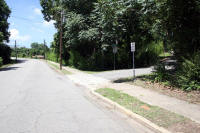
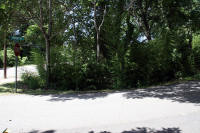
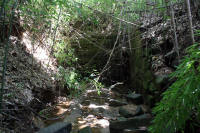
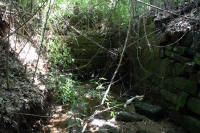
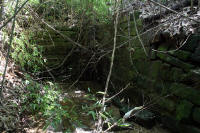
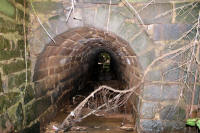
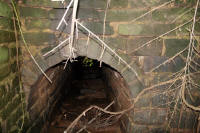
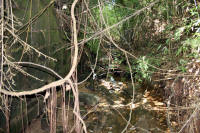
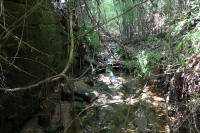
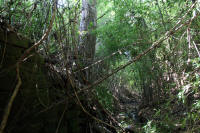

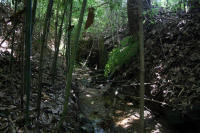

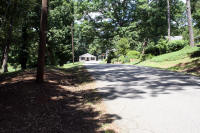
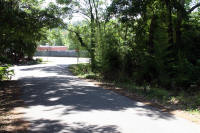
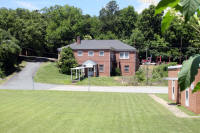
One thing I noticed, there isn't any type of guard rail or barriers to
prevent one from going into the ravine. As TD stated, it is at least
15 feet deep from the surface of the road and some good sized rocks from the
construction of the culvert are still on the creek bed. I included a
pix of where TD lived back then at the end of Mimosa Terrance adjacent N.
Green Street and the last picture is where the Woodman of the World (WOW)
park was located in 1934 which the large building was The Anson County
Health Department at the time I was harvesting squirrels in this area in the
early 1960s. The building in the right hand edge of the pix was built much
later and was used by the Firemen for training purposes, etc. There
was also a log cabin in the park but can't remember when it was torn down.
Aunt Mollie Bowers also stated that the Church of God members used the WOW
park for their annual home comings before they built the Church of God on N.
Green Street.
Quote TD Burns, "In the Park's hay-day, the W.O.W. held public fish
fries there and brother Herbert and I helped with the fires, setting up the
tables and serving for their free meals. They kept all of the supplies for
doing these in that log cabin." TD wrote an excellent story about the
park and I will copy it and hyperlink it here for reference.
My Aunt Mollie Bowers related to me (who was not an eye witness) that Joe
was riding in the front seat of the car between the Luckadoo Brothers and
was going too fast and lost control of the car and both of them were able to
jump out in time before the car went down into the deep ravine, whereas Joe
wasn't able to jump free as they had done and Joe suffered an injury to his
head and later died in the local hospital. Grandma Coley at that time,
had what we would call today a nervous or mental breakdown by what I have
been told by her children. After Joe died, Grandma didn't attend
Church after the accident for about 2 1/2 to 3 years, apparently blaming God
for what happened. During those years, her oldest daughter Elizabeth
being 13 years old looked after the siblings and Grandma still did the
cooking but not too much else. Grandma would walk from 910 Maple
Lane to the
Hanna Chapel United Methodist Church
cemetery on Highway 109S which is a good four (4) mile walk and stay there
for hours and hours at Joe's grave site and sometimes would catch a ride
back home but most of the time she walked it. Aunt Mollie said Mr.
Coley was very patient during this time and that certainly was a display of
his true love for her. The Father of the Luckadoo brothers who was an
atheist later asked my Grandma, "Do
you still believe in God now" of which she said, "Instantly,
it was like a fire had come over her and she replied to him that God didn't
have anything to do with that accident, it was caused by Man." From
that point on she began the road to recovery and was able to go back to
Church, sing and play the piano and/or organ again and resume a normal life,
however I don't think one would fully ever get over losing their child.
Again, this was related to me on 06-10-15 by my Aunt Mollie Bowers.
It is ironic that God used the words of a confessed atheist to snap her out
of her depression focusing back on the Love of God! I
am personally familiar with that area since I use to sneak into the heavily
wooded area in the early to mid 1960s and harvest squirrels to trade for .22
caliber ammunition and 20 gauge shotgun shells. The area on the West
Knitting Mill side of the road has been clear cut for the most part since
then with businesses on the back side of the property on Highway 74.
Ken Ackerman related to me that his mother Elizabeth "Sis" Ackerman always
thought that the wreck was suspicious in nature and might have been
intentional by the Luckadoo brothers since they were able to jump free from
the vehicle in time before going down into the deep ravine. Also, the
law of physics applied to the accident scene would suggest that the vehicle
if going too fast and then attempted to make the sharp right turn onto
Mimosa Terrance, the car would in all probability do a complete roll over
instead of going straight down into the ravine. Also, T.D. Burns found
a rusted out pistol/revolver at the other end of the culvert four (4) years
later adding a little credence to those suspicions that Aunt "Sis" had.
The accident happened on a Friday which was Joe's payday from Wade
Manufacturing Co. and according to Aunt Sis Ackerman, there was no money
found on Joe which leads to all kind of theories and speculations as to what
he was doing in the vehicle with the Luckadoo brothers and what happened to
his money. The
Death Certificate list the principal cause
of death as a fractured skull injured in auto accident.
MARY HELEN COLEY DUTTON
Virginia Mowery Coley, Joe's widow and Daughter Mary Helen Coley lived with
her Grandmother Helen Mowery and a Great Aunt Flora Deese at 212 Wheeler Street
documented on the
1940 Census taken until she was 8
years old. Virginia Mowery Coley later married Odell Williams in 1942
and they lived on Burnsville Street until they they build a home on Sikes
Avenue when Mary Helen Coley was 15 years old. My Uncle Jesse Mack
Coley, Jr. built a house beside them on one of the lots deeded to him prior
to Mr. Jesse Mack Coley's death. About all I can remember of Odell and
Virginia Williams is when they came home from work from the mill, they would
sit on the front porch of their home and relax before supper while my cousin
Johnny Ray Coley and myself would be playing as normal young boys do.
I have
detailed when J. Mack Coley, Jr. sold Odell and Virginia the lot
on Sikes Avenue to build their home on a few paragraphs down.
ADDITIONAL PROPERTY TRANSFER INFORMATION
Prior to the Singleton Silk Mill closing in 1926/1927, Mr. Coley purchased
ten (10) of the mill homes for five thousand dollars ($5,000.00) (per my
Grandma and Mollie Coley Bowers) before the local banks stopped loaning money right
at the start of
The Great Depression
of which he rented them out. That
transaction can be verified by the
deed granted to him in 1921, however actual money paid for the
lots remain obscure. I do know for a fact the rent was $ 4.00
per week in the early to mid 1960s but don't know what the rent was back in
the 1930s. I never remember Grandma going up on the rent and doubt she
earned much money from the properties at that time due to the age and
condition of the wood frame houses along with the required up keep for the
properties.
It is to my understanding that Mr. Coley provided Elizabeth "Sis" and Cecil
Ackerman a house to live in on the corner of
Sikes Avenue
and Maple Lane where Charles, Risden and Julian were born and
they later moved up the street into another one of Mr. Coley's houses.
Mr. Coley later gave his first daughter
Elizabeth "Sis" Coley Ackerman and Cecil
Ackerman their peach orchard in Morven, NC on December 17, 1945 consisting
of about 40 and 1/20 acres more or less, documented in this .pdf file titled
Jesse Mack Coley & Della Coley to Cecil & Elizabeth
Ackerman which details the land transfer of which her spouse
Cecil Ackerman later pulled all the peach
trees up and planted watermelons and pine trees since most of the peach
trees were far past their prime according to their oldest son
Charles Ackerman who related to me that he
helped his Dad pull the peach trees up and hated to up root the few that
were still producing good peaches. Cecil
Ackerman with the help of Doug Coley, built a 700 foot square
block home (current 2015 pix) around 1950
and "Sis" and Cecil raised there eight (8) children there. Ken
Ackerman related to me that Cecil used some of the Pine tree timber cut off
the property to build their home from. I remember as a small boy
visiting the Ackerman family with our family and Aunt "Sis" would usually
have some wonderful homemade watermelon rine preserves on hand.
Elizabeth (Aunt "Sis") Coley Ackerman has detailed accounts of where they
lived written in her own words in this .pdf document titled,
Elizabeth Coley Ackerman's story.
While searching for additional information at the
Anson County Register of Deeds Office here in Wadesboro, I checked the
Grantor/Grantee index listing again and located additional property that Elizabeth
"Sis" and Cecil Ackerman had purchased, being 28 1/2 aces of land more or less
located in Lilesville, NC on
March 21, 1947 from L. B. Martin and wife Minnie Martin, whereas according
to the tax stamp value fee of .55 cents per 500 dollars at that time, they
paid 1000 dollars for the track of land. They sold the land to
Elizabeth's brother Doug on July 31, 1948 for the same amount per the tax
stamp. Doug and Hattie Coley sold the land on January 13, 1951 to L.
E. Ingram and others, however there wasn't a tax stamp on the document.
I have a copy the deeds hyperlinked
here.
Aunt Sis and Uncle Cecil Ackerman sold the farm and home and built a split
level home here in Wadesboro on McRae Road moving into the home in August of
1957, whereas Cecil was a Contractor at the time. According to
their youngest son
Ken Ackerman, he related to me on 06-12-15,
they used good 5/4 full thickness pine lumber that was recycled from a house
they had earlier torn down to construct the sub floors, roofing and framing.
Jesse McKnight "Mack" Coley and Della also deeded their oldest son J. Mack
Coley, Jr. property on Sikes Avenue dated December 27, 1945 detailed in this
four (4) page .pdf file document titled
J.
Mack Coley, Jr. Deed Info. of which he eventually built his home
on and later sold the property to H. Brill Huntley and wife in June, 1969,
whereas he purchased a home on 403 White Store Road. J. Mack Coley,
Jr. and his wife sold Odell & Virginia Williams one of those lots mentioned
above on September 28, 1946 documented in this .pdf file titled
Coley, Jr. to Odell Williams Deed.
Mr. Coley and "Della" also provided my
Mom and
Dad with a home to live in as well as Doug &
Hattie Coley and Aunt "Mollie" and Baxter Bowers (rent free) for a period of
time until they built or purchased their own homes. Grandma related to me
that she would fuss at Mr. Coley about purchasing all those houses and he
said he was doing it so she would have an income since he was 31 years older
and she would not have to work as hard as she did earlier in life.
Mr.
Coley could not foresee the tremendous outlay of cash needed later on when
the city installed a sewage system and required all the homes in the city
limits have indoor bathrooms hooked up to the city sewage system which was
years down the road. He was certainly thinking ahead for her financial
needs in my humble opinion. Mr. Coley was definitely a very brilliant
and smart business man and the people that I have interviewed said that he
always had money to lend. He suffered a stroke in May,
1945 and prior to that had slowed down quite a lot, no longer able to plant
a garden by himself. Jesse McKnight "Mack"
Coley died on June 19, 1946 and buried
beside
Joseph Julian Coley his adopted son in the
Hanna Chapel United Methodist Cemetery here in Wadesboro off Highway 109S.
I have never heard any negative things about Mr. Coley and Ben Deese,
deceased who was about the age of Joseph Julian Coley related to my Brother
Allen Porter many years later that Mr. Coley had loaned him some money to
purchase dishes, pots n pans, etc. to start his marriage and he said that
Mr. Coley was an honest and fair man but
"tight as the bark on a tree."
Mr. Coley was very frugal but
didn't want for anything! Mr. Coley later in life did own one ole farm
truck that his son Mack, Jr. drove to haul fertilizer, etc. according to
Aunt Mollie Bowers.
One of my music friends,
Brutus Gale, banjo picker, (deceased) who
operated a shoe repair shop in Wadesboro near S Rutherford Street and Martin
Street for many decades, related to me back in the early 1970s that he knew
Mr. Coley and that "He was so tight, that he
would skin a flea for his hide and tallow." Grandma use
to tell me how he picked up every nail, piece of string or anything that
could be later used and never threw anything away either....grin if you
must! One thing is for certain, Mr. Coley wasn't afraid of work and he
knew how to earn money. I remember Grandma Coley telling me that Mr.
Coley said,
"When a man gets to where he will not work, he
will get either one of two jobs; selling insurance or become a Policeman."
Mr. Coley understood about physical work for sure and apparently didn't
appreciate the non-manual labor type of work.....grin if you must!
GRANDMA COLEY AND THE SMOKEHOUSE
June Bowers, Aunt Mollie Bowers eldest daughter was going through her photo
albums recently and ran across the old photograph below which leads into a
story that Aunt Mollie related to me. Below is the photograph of Ann
Coley on the left with Risden Ackerman in front of her and Mollie Coley on
the right with Charles Ackerman in front of her and the time would be around
1940:
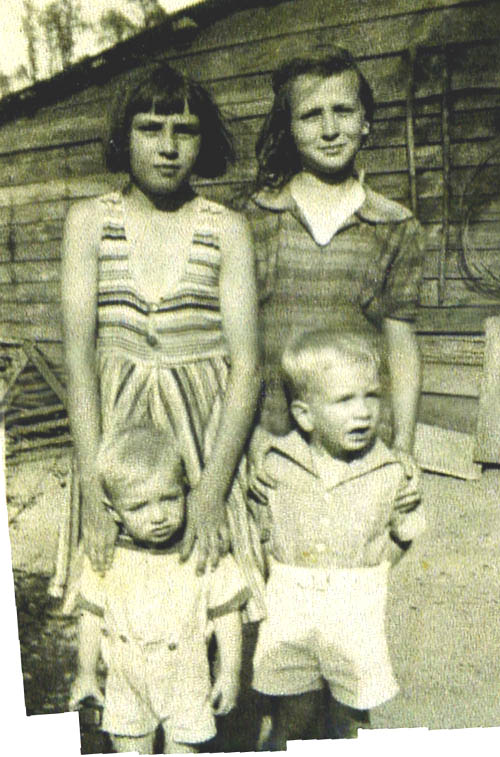
I was curious about the building in the background and called Aunt Mollie
and she said it was a
smokehouse they used for curing and hanging
meat but later used the smokehouse only to store ole items like a single
tree, mule halters and other farm implements used when they plowed their
mule Pete. The smokehouse wasn't there in the 1950s when I lived with
Grandma Coley, therefore don't remember it but I do remember the barn they
kept Pete with various types of old hand tools and a large
wheat sickle and another structure
for the cow and/or pigs. Aunt Mollie related to me the story behind
the smokehouse, whereas she said that her Dad would go to town each Saturday
and stay gone for most of the day. Aunt Mollie said that while Mr.
Coley was gone to town, Grandma Coley got some of the men from up the hill
to come and tear the ole smokehouse down and take all the wood and the
buildings contents down below the hillside next to the branch out of sight.
She was tired of looking at the ole smokehouse since they didn't use it
anymore. The men after removing the smokehouse raked the place up real
well and you could hardly tell there ever was a smokehouse there. That
afternoon when Mr. Coley returned home, (with Mollie and Ann watching) Mr.
Coley stopped at the entrance to their
driveway near a sweet gum tree looking around and called Della to come out
from the house. Mr. Coley said, "Della, wasn't there a smokehouse out
back when I left this morning and now it is gone, what happened to it?"
Grandma told Mr. Coley, "Yes there was and that she had some men from up the hill to tear it
down and put the wood and things that was in it below the hillside next to
the branch out of sight." Mr. Coley raised his voice just a little and
said "That was all right but he wanted the men on Monday to bring everything
that was in the smokehouse brought back to the house." Grandma Coley
said, "Where am I going to put the stuff" and Mr. Coley said, "You figure it
out" and never said another word about it again.
Mollie said Mr. Coley was a very happy man and he would be whistling most of
the time and rarely ever got upset or raised his voice. She said he
wore dress type slacks and a white or colored shirt most of the time and
when he did any work around the home place, he wore khaki pants made from
some type of heavy cotton/canvas material. Aunt Mollie said she
never saw her Dad in a pair of overalls and he wore suspenders most of the
time.
POSSUM AND RABBIT HUNTING
Grandma Coley related to me and also Uncle Doug how Mr. Coley loved to
"possum" hunt at night by lantern and they had possum dogs that
would tree them. Uncle Doug and Mack would shake the possums out of
the tree once treed by the hound dogs and put them into a burlap sack.
Doug said on one hunt, one of the possums bit him through the burlap sack on
his back and he let the bag full of possums fall to the ground and all the
possums ran out. Grandma said Mr. Coley would place the live possums
in a pen and feed them for a couple weeks (mostly cornbread and buttermilk)
to clean them out since possums would eat anything dead, etc. Grandma
said that Mr. Coley loved baked possum with baked sweet potatoes and also
fried pork chops.
Uncle Douglas Ross Coley told me that his Dad, Mr. Coley, Mack, Jr., himself
and maybe one other person, probably Clifford Coley rabbit hunted down 52
South toward Morven in the area in front of the Jones Creek Fish Camp
traveling there by mule and wagon. Doug stated that they killed so
many rabbits that day, the back of the small wagon was loaded down with
rabbits of which they skinned, dressed and salted them down to preserve for
later usage. I don't know the number of rabbits they harvested but one
can image it was a large quantity for sure. In all probability, Mr.
Coley's hound dog ole Blue was jumping and running the rabbits for them.
ELICK GADDY AND THE HOT WIRE FENCE
While still reflecting on the past, I will relate an incident that I
observed the aftermath of. Mr. Coley during his years at Maple Lane
used a young "hired hand" named Elick Gaddy (now deceased) who lived two
streets over to do things for him like plowing the land, etc., per family
members. I remember that Grandma Coley also hired Elick to do various
chores when I was a small boy as well. Now, finally getting to my
memory from the past, Uncle Doug installed a single or double strand hot
wire fence around the field behind Grandmas home encompassing the barn and
hog lot which probably took in more than an acre of land which went right
down beside the branch. That branch flows behind the property and
flows all the way to the Anson County Airport area and goes through a stone
culvert underneath the Seaboard Coastline railroad tracks. At some
point in time many decades ago, there was a small brick/stone dam on the
branch/creek about 200 yards from the railroad tracks that was gated to back
the water up creating a small mill pond which supplied the water to some
type of steam powered saw mill as evidenced by the concrete slabs and steel
pipes that were located not to far from the dam structure mentioned.
The rumor was that Elick had
himself a moonshine still on the branch since a good supply of running water
is needed to cool down the condenser coils to turn the steam back into a
liquid and the word quickly gets out as to who can supply illegal moonshine
or bonded "bootleg" whiskey as Anson County was a dry county at the time.
One day I was going to the railroad tracks as young boys get out and about
to explore things on a regular basis and when I got to the other side of the
hog pasture that had the hot wires installed, I noticed a large brown paper
bag that was left near the hot wire fence and several quart Mason jars were
lying on the ground beside the paper bag and broken of which smelled of
moonshine. It appeared that Elick had come through there during the
night on a well used path on his return trip from his
alleged moonshine still not realizing that a hot wire had
been recently installed. Elick must have thought the devil or
something had gotten a hold of him because he certainly dropped his bag of
moonshine; that would have been a Kodiak moment for sure and would probably
take top spot on some of the best video shows of today. We certainly
got a humongous laugh from that and I am stilling grinning today when I
think about it. Whether or not Elick ever admitted to the "moonshine
drop", I don't know. I have personally found a moonshine still on that
same branch/creek when I was a teenager that was probably a mile on the
other side of the railroad tracks which had the mash (corn meal, sugar and
yeast working off) in a couple 55 gallon metal drums, however the copper
condenser coil and thump keg was not installed on the barrel mash cooker of
which most were constructed from copper. I turned over the mash
barrels emptying their contents and put several .22 caliber rounds through
all the components of the moonshine still after checking to see that no one
was nearby and then ran like a scalded dog out of there. I sure did
cost some moonshines (could have been Elick's still) a good chunk of money
that time and now realize how lucky I was because I could have gotten
seriously hurt or killed for my actions.
I found another 55 gallon metal drum operational moonshine still in front of
McLeod's Box Factory on Highway 52N on a little branch between the railroad
tracks and a nearby home but didn't bother it.
I hunted and trapped that branch/creek until I enlisted in the US Navy in
1964. Click on this short
story which details some of my exploits with my all time favorite
dog Brownie.
Grandma said Mr. Coley was in fairly good physical condition and health
until his stroke although he has slowed down and not able to do any serious
manual work like plowing his mule, etc. There is a
picture taken of Mr. Coley holding myself in 1946 with my Mom in
the background and he told Grandma right before he died to
"take care of the baby" and she
said, "Who, Ann?" and he said "No", referring to me and not my Mother who
was the "baby" of their family being fifteen (15) years old at the time.
Grandma sure kept her word to Mr. Coley because she did take care of "yours
truly" the best that she knew how! The fold away iron hospital bed
they purchased when Mr. Coley had his stroke was still in the Coley home in
the 1960s stored in a closet in my bedroom.
Grandma and Mr. Coley's home did not have central heat, air or insulation
and getting up on those cold winter mornings with hardwood flooring; one did
not linger around too long before getting dressed. The original wiring
in the home was the single heavy gauge wire covered with insulation that was
secured to ceramic/glass insulator posts and the two wires strung along side
by side in the attic on the ceiling joists. There wasn't any 220VAC
available if memory is correct either since Grandma used a gas range and had
a wood cook stove much earlier. It was much later that more modern
wiring replaced some of the old. There were two Seigler brand kerosene heaters
in the home and until around 1960 or so there was a full sized cast iron
wood burning cook stove in the kitchen along side a more modern gas range.
Grandma made some “beautimous”
tasting buttermilk lard biscuits baked in that cast iron wood cook stove and
you better believe I did eat my share of them. Grandma gave that cast
iron wood cook stove to Josephine Gaddy after their
house fire sometime in the early 1960s of
which the house has been renovated a couple times since then due to fires.
GRANDMAS MILK COW, BUTTER & BUTTERMILK BISCUITS
As far back as I can remember, Grandma Coley owned a milk cow of what breed
I don't have any idea, although I know it wasn't a Jersey or Holstein as I
am familiar with those breeds. I recall as a small boy probably 10
years old, the small pasture behind Grandma's home place was fenced in of
which it took a good amount of climbing to get over the wood portion of the
fence near the outside faucet so I had to be small at the time.
If Grandma named her cows, I don't remember whereas she owned one that was
very territorial over her fenced in area. Anyone that entered that
pasture needed to have their eyes fixed on where the cow was located or
thought she was located because on the right hand side of the pasture, the
terrain dropped off toward the branch and you could not see over the knoll.
As soon as the cow spotted you, the race was on because she headed straight
toward you and you needed to be within running distance to make it to the
closest part of the fence to make your exit and you had to do it very
quickly. Many times I came close to not calculating the cows distances
from myself to the cow and I had to run at a break neck speed to avoid
getting butted by the cow. For what ever reason, that cow loved to
head butt a person and it might have been the chase the cow enjoyed more so
than catching up with the individual trying to cross "her pasture."
There is one incident that I recall, where Aunt Hattie Coley was attempting
to cross the pasture and those that were watching said that Hattie Coley was
running so fast that her shoulder length hair was straight out behind her
head and the cow's tail was straight out into the wind as well. I
don't know whether I was there at the time or it was told to me but it
remains in my "minds eye" as if I witnessed the event.....grin if you must!
I remember the last calf that Grandma Coley was raising from the old cow and
it died while it was still young and that was the last cow that Grandma
owned and goodbye to the home made butter but I think she was still able to
purchase some butter produced by other people at the time.
I remember eating the first store bought
Oleo margarine and that was horrible
tasting stuff since I was raised on eating real home made butter. Ok,
I know I am aging myself on this one.....grin if you must!
CHURNING BUTTER
In order for a cow to produce milk, she has to be impregnated and there is
only a few months out of the year between impregnation, giving birth and the
cycle continues over again if you want to have fresh milk on a regular
basis. One of the benefits of fresh refrigerated milk is that the
pure cream will settle on top of
the milk and that is the secret to what makes the most wonderful home made
pound cakes there has ever been. I am not saying you can't accomplish
the same thing using homogenized whole cream but the old way seemed better.
Another benefit of the milk cow is the production of pure butter which is
made by separating the cream from the milk and placing in into a butter
churn and agitating it with a wooden paddle called a dasher that the upper
portion of the handle is inserted through a hole in the top of the churn
lid. Believe me, I have done a good amount of that hand churning while
living with Grandma until she was no longer able to keep a cow. After
a certain amount of churning; pumping that paddle up and down which seemed
like forever for a small boy, the fat content from the cream (butter) would
separate and float on top which would be collected and placed in a type of
cheese cloth and the liquid pressed out with only pure butter remaining.
Grandma had an assortment of wooden butter mold bowls with carved designs on
them that she placed the butter into to allow the butter to harden.
Below is a pix of a similar butter churn that we used back then:
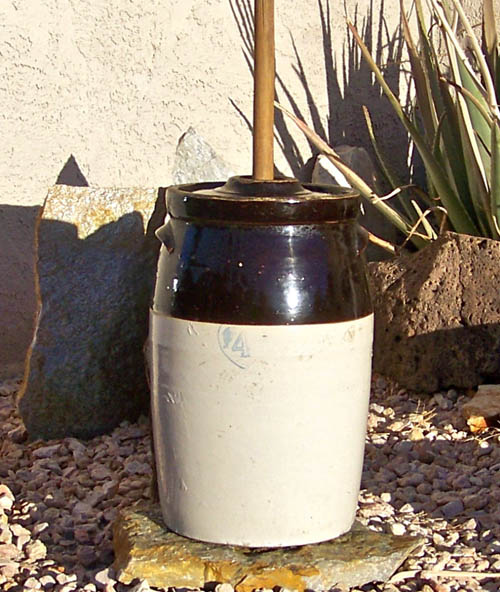
Below pix of an antique butter/mold press:

BUTTERMILK BISCUITS
A by product of this butter producing was buttermilk that was then
refrigerated. Grandma Coley made some of the best buttermilk lard
biscuits I have ever eaten. My bride also makes some wonderful
buttermilk lard biscuits and over the years
we have eaten our share of them and my bride's buttermilk lard biscuits are
off the chart too! We don't eat them like we use to trying to hold
down on some of the things that make one's waist line enlarge.....grin if
you must. Below is a pix of some of those wonderful buttermilk lard
biscuits that my bride baked:

Grandma Coley didn't use any real measurements, instead she had a large
elongated wooden bowl that was kept in her wooden flour bin on the back
porch which would probably hold 50 pounds or more of all-purpose flour that
was packaged in printed design
cotton sacks of which the cloth was used to
make clothing items such as dresses and shirts, etc., back during The Great
Depression Era up until the 1970s. The wooden bin had a large deep
drawer that was on a pivot and would swing open forward resting against a
stop whereby revealing its contents and you could sift the flour into the
wooden bowl. Grandma or myself would add a good amount of flour to the
wooden bowl and bring it back into the kitchen and place it on the kitchen
table. She would rake out a depression in the center of the flour and
add pure lard that was retrieved from a tin lard stand close by being about
3 gallons in size, whereas she would get at least 1/3 cup
(guesstimate) and using one hand only, slowly began pulling
flour from the side of the bowl into the center and kept mixing it by hand
until she got it like she wanted it. She then added buttermilk, baking
powder and salt, don't remember any measurements and mixed it and pulled
flour from the side of the bowl until it was the right consistency.
She then took the dough ball and placed it on the floured kitchen table and
kneading it back and forth and flattened it out using a wood rolling pin.
She didn't use a biscuit cutter but "choked" off a piece of the dough
between her thumb and first finger, rolled it in her hands and then placed
it on the biscuit baking pan and flattened it out with the back of her
fingers and knuckles. I called those biscuits
"Cat-head biscuits" because when
baked those golden brown beauties were about the size of a cat's head and
before 1960 she baked them in a cast iron wood stove. Those were some
of the best tasting biscuits I have ever eaten and I believe the wood stove
was the "secret" ingredient that is missing from our modern gas and electric
ovens; the additional flavor imparted by the hickory or oak wood used.
By the mid 1960s, Grandma was no longer baking home made biscuits due to
health issues like arthritis in her knuckles and hands and using canned
biscuits instead but I sure do remember those fantastic biscuits she made.
Below pix of an antique wooden mixing bowl, but Grandma's bowl was much
longer somewhere in the neighborhood of 18 inches in length whereas this one
is less than 12 inches:
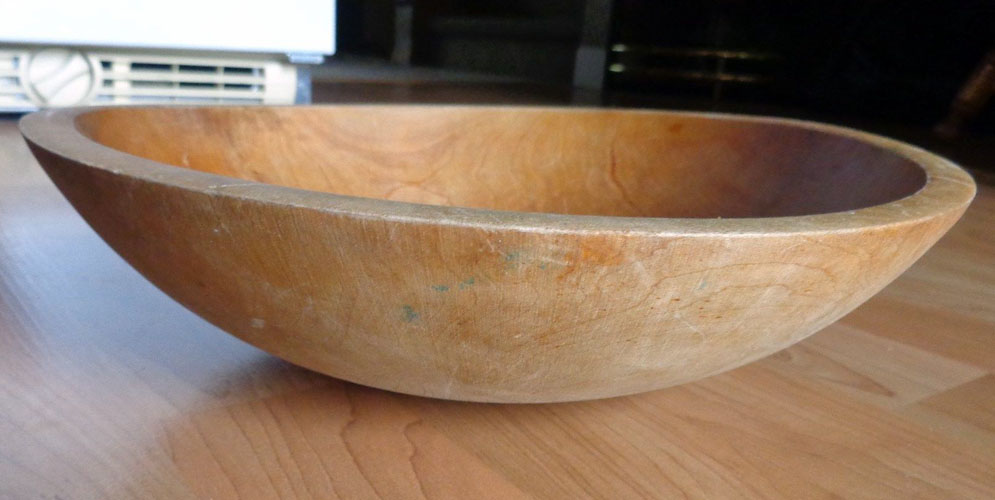
Also, the pure lard used back then was home produced as well from the hogs
that were raised out back and I go into a little detail in the next sentence
that has a hyperlink. Coupled that with home made hot length dried
sausage or
hot sage sausage
and local brown sugar cured ham, it didn't get any better than that.
Those days are long gone but are still wonderful memories from the past!
OLE "CRIP" THE GAME ROOSTER
During the time Grandma had her cow and again, as far back as I can remember
even to the lower grades in school, there were chickens kept in moveable
chicken coops and a few free ranging chickens and also the barn had some hen nest boxes where the hens would
lay their eggs. There was at least one roster or two kept to service
the hens to keep the egg production going.....grin if you must!
I remember one time while attempting to get a chicken out of the chicken
coop that was destined for the dinner table, an ole roster spurred me on the
back as I was squatted down getting the hen from the coop as she was making
all kinds of racket which got the attention of the rooster. I let the
hen go and the roster won that time. We had a few Rhode Island Reds
and a bunch of the Dominique also known as Dominicker hens which were good
egg layers and they also eat pretty good as Southern Fried Chicken and
Chicken and Dumplings when they were no longer producing a quantity of fresh
eggs!
One particular game roster we had was bad to run you and try to spur you and
you had to be on the lookout for him. Well, later that ole rooster met
his match. There was a car that came by the house driving real slow
and the ole rooster ran out to the road and attempted to spur one of the
tires and got one of his feet under the wheel and that is where he got the
nickname CRIP from. Ole Crip would still try and spur you and come up
to you walking sideways in an aggressive posture and stance but the sting
had been taken out of him by his damaged foot. Don't know what
happened to ole Crip but he probably ended up in a pot of Grandma's Chicken
and Dumplings.
RAISING AND PROCESSING HOGS FOR THE TABLE
As far back as I can remember, pigs were raised and slaughtered at Grandma
Coley's place until the early to mid 1960s and many today don't think about
the production of poultry, beef, pork and other meats consumed; they just
purchase it at the supermarket or local grocery store and/or meat market for
the bigger city folks.
I have already posted some of this information at various places through out
this website on another short story and/or a particular recipe but will
include tidbits of information here to go along with this memories from the
past story.
Remnants of the ole hog lot was still standing in the late 1960s when I
returned home from a four year tour of duty in the US Navy but it is all
grown up today nearly to the back door of the old home place at 910 Maple
Lane. Grandma also had a small tin covered shed with wooden sides and
one open end that the pigs and/or cow stayed in.
Those that have lived on a small farm or a home place that allows farm
animals within the city limits know first hand the work involved to raise
pigs to reach anywhere from 200 to 600 lbs. or more depending on what breed
of hog you have. Most of the hogs we raised were in the neighborhood
of 200 pounds, however a Yorkshire, American Hampshire, Berkshire or Poland
China can get much larger within one year. Many years ago, hogs could
be fed a diet of "slop" any kind of vegetable and meat scraps from homes,
restaurants, schools, grocery stores, etc., but that is no longer the case
as those type of food items now have to be cooked to a certain temperature
for health reasons. Therefore, the added cost is not worth the trouble
for pigs raised on production. I am sure small family farm operations
who utilize the meat for themselves no doubt still do it the old way with
left over food items supplemented by commercial hog feed and cracked corn.
Feeding hogs or any livestock is a daily job requiring physical work to put
weight on the animal ready to be slaughtered. There would usually be a
pair of piglets purchased in the spring and fed through out the year until
it was in the colder months; e.g., December through February to process the
adult hogs in the colder weather without fear of the meat spoiling during
the processing and flies and other insects contaminating the fresh meat.
Prior to dispatching (killing the hogs), a couple cast iron
wash pots,
estimating around 30 gallons or more each would be fillet with water and a wood fire
ignited underneath and around them to get the water right at the boiling
stage. A large angled hole would be dug into the ground at about a 45
degree angle or less to allow a 55 metal drum with one end open to rest in and
everything would be ready. There was a very large
Chinaberry tree in
the back yard that had large overhanging limbs that was used to hold a
single
block
and tackle pulley which was used to hoist the hog off the ground. All
the tools necessary to complete the job would be ready; knife, hand saw,
axe and/or hatchet, hammer, old solid one piece zinc metal canning lids that had the edges sharpened,
water transfer bucket and a clean sheet on a table on the back porch to
process the meat. There probably was some type of ground cloth
(canvas) adjacent the hot water barrel bath but can't remember the details
for sure.
Once all of the above was in place and the water scalding hot, it was time to
take the truck and the .22 caliber rifle down to the hog pen and coach the
hogs into the pen with some hog food, corn, etc. and once at the hog trough,
a bullet was fired into the brain of which the hog immediately went straight
down. Usually the other hog wouldn't pay any attention to what was
going on and the same thing was repeated. The hogs jugular vein was
cut into allowing the hog to bleed out and the heart would continue to pump
blood until the blood supply was emptied.
It took several men to load the hogs onto the back of a pick-up truck and/or
sled dragged behind the truck of which they were brought to the back yard where
the hot scalding water and barrel was ready. The hog would be dragged
to the barrel where hot water was dipped into the barrel and one end of the
hog was placed into the scalding hot water and would be allowed to stay
there for a short period of time and then rotated 180 degrees around inside
the barrel and then pulled from the barrel and if the hot water was at the
correct temperature, the hog's hair could easily be removed. The old
blue colored solid top reusable Mason jar lids with the sharpened edges
would be used to scrap the hair from the hog. The other end of the hog
was placed into the barrel with more hot scalding water and the procedure
repeated itself. Sometimes the other hog outside the barrel would have
scalding water poured onto it and a burlap sack would be used to cover the
hog until the other hog's hair was totally removed.
Once, the hog's hair was removed, a slit between each of the hogs hind tendon and
leg was made and a wooden
single tree with a metal hook on each end was placed between each leg
hooking the tendon and the hog was
hoisted off the ground using the mechanical advantage of the block and
tackle securing the end of the rope to the chinaberry tree. Any debris
and loose hair from the ground was washed off the hog carcass with a water hose.
This was a very fast operation done to prevent any possibility of meat
spoilage and the cold weather was the key to success along with the other
variables such as proper salt curing.
The hogs pelvic bone was cut through using a large heavy hunting knife and hammer being
careful not to pierce the last part of the intestine at the anal opening.
The rectum (anal opening) was cut all the way around and detached from the
pelvic bone and tied off with a string to prevent feces from contaminating
the meat. The hog was cut into from the hind quarters down the center
of the belly to the neck being careful not to pierce the intestines being
collected in a large tin tub, of
which the liver, heart and intestines were saved for later usage.
Once the hog was eviscerated, (everything inside the body cavity removed),
the hog head was removed and the carcass was split in half using a hand saw
from the hind quarters to the neck and each half taken onto the back porch
for further processing; removing the hind quarters aka hams, the shoulders,
and continuing to process each loin (pork chops), side meat for bacon
and the balance of the fat meat cooked in one of the wash pots to render pure
lard.
When straining the liquid fat (lard), the cooked meat residue left called
crackling was reserved to be added to cornbread. The head was boiled and stripped of its meat and used to make
souse meat aka head cheese and the hogs head was split open and
the brain saved for some brains and eggs at breakfast, prior to boiling the
hog head. You have to be tough to eat brains and eggs for
breakfast.....grin if you must!
The liver was used for making liver mush and liver pudding and the
intestines were washed clean using a hose pipe and used to stuff ground red
pepper sausage
into which was hung and dry cured and/or sausage patties were formed.
Liver has not been one of my desirable meat items, although I will consume a
good deep fried chicken liver once in a while but not too often.
The shoulders and any other usable meat was deboned and ground to make sausage and the
hams were placed in a very large wooden rectangular shaped box that
contained salt and the hams were totally covered with regular table salt to
leach the moisture from the hams requiring about 1.5 days per pound for each
ham. After the salt leaching process, the hams were removed and soaked
in water and scrubbed clean and then dried ready to sugar cure them using a
heavy mixture of black pepper, red pepper, brown sugar and molasses.
The hams were coated with this mixture after the salt leaching process which
took several weeks and wrapped in cloth and/or heavy brown paper and allowed
to hang in a cool place for a couple months until ready to use. The
cold weather was definitely required to keep the meat from spoiling until
the meat was processed. I remember cutting pieces of meat from the
hanging ham that was cured and it was delicious but a little salty.
Country cured home gives off a wonderful aroma when frying in a skillet and
placing a piece of that cooked country ham between a good home made
buttermilk lard
biscuit, that is hard to beat!
Uncle Doug Coley was in charge of the hog killing process from start to
finish and had been doing it with Grandpa Coley and others since he was a
small lad big enough to help and had the exact procedures down to a science.
I wish I had paid some serious attention to the exact method that he used as
to whether he used saltpeter, borax or another type of cure such as Morton
Tender Quick to help keep to beetles from getting into the curing ham.
There are several articles on salt curing meat and this
hyperlink will give you additional
information.
JASPER MARSHALL
Jasper Marshall back in the 1960s and much earlier, use to service the
Seigler oil heaters that was in Grandma Coley's home. Jasper worked
for Brill Huntley servicing oil heaters for his rental properties and their
kerosene oil customers. Jasper had many jobs over the decades
including Little Cotton Manufacturing Co., Wansona, Wadesboro Hardware, H.
W. Little Co. In addition to all those jobs, Jasper farmed and has
been a staple fixture at the local Anson County Farmers Market located on
Highway 52 South.
While at the Farmer's Market this morning on 07-11-15, I purchased some of
Jaspers home grown tomatoes and a package of his "home grown" country ham
too. Jasper and myself had a good long talk going back in time
reflecting on the past and he remembered our family and related to me that
Grandma Coley would also invite him for a meal when he was doing the service
work on her oil heaters. Jasper is 84 years old and certainly looks
much younger than that and his mind is sharp as a tack too! Many years
back, my bride worked with his bride at the Carl's Food Center here in
Wadesboro which is now IGA.
Below is a pix of Jasper at the Farmer's Market:
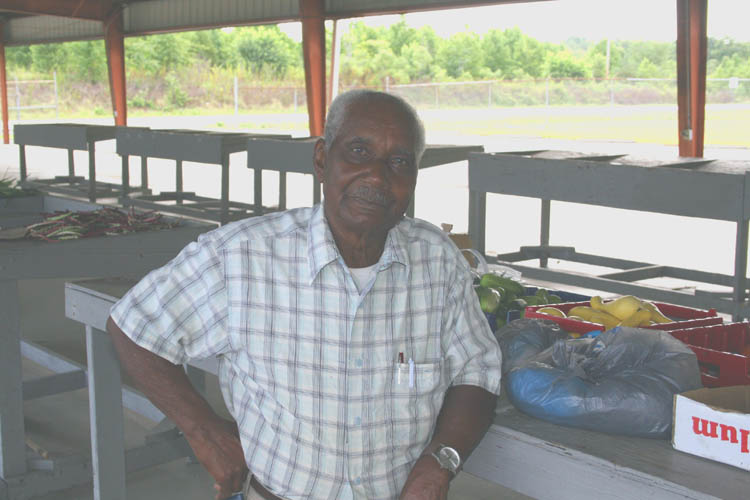
I was brain dead operating the camera this morning, having trouble with the
flash and a "back lighted" situation and will take a much better picture the
next time I am at the Farmer's Market.
With the drought we have experienced this spring and summer, there wasn't as
many farmers at the market as usual due to not having anything to sell.
Also, many of the "ole folks" that were there for decades have long since
passed on and the younger generation are not as active into farming like
their parents and Grand parents. Another pix of Jasper
below:
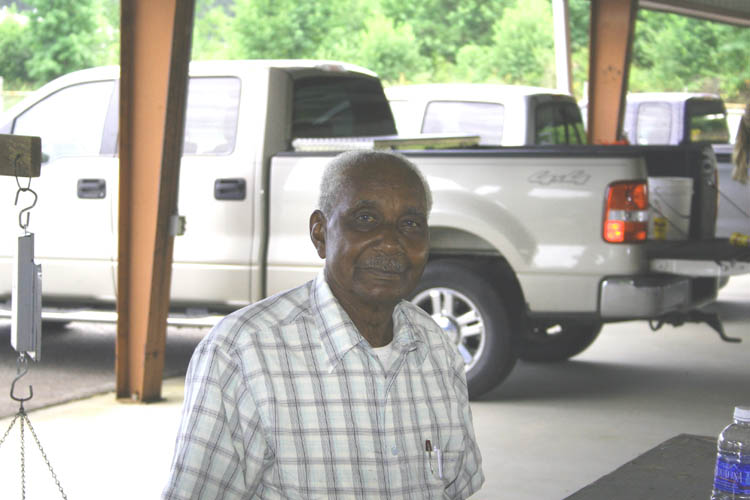
MEMORIES FROM THE PAST CONTINUED
Fond memories still linger of the many conversations Grandma Coley and
myself had in the front living room with each of us sitting beside the oil
heater in our own wooden rocking chair with Grandma telling me about how
things were back when the lifestyle was much different. I know many
older generation people that said they would like to go back when things
were much simpler but Grandma had no such desire because life for her
growing up was very hard and difficult. As a young girl, she had to
help support her invalid Dad and help look after the family, as her mother
was deceased. She worked 12 hour shifts as a silk winder at the ole
Singleton
Silk Mill (Circa 1888-1926) on Sikes Avenue to help support her
family where now is located a housing development (Wadesboro Housing
Authority) and a large water tank in
the middle of the plateau or highest elevation on the property. The
old silk mill was still standing in the early 1960’s and many times we would
sneak into the mill climbing up to the third story (we counted the partial
basement on one end as a story) looking out across the countryside.
There were Confederate Civil War uniforms and a sword on the 2nd floor
(middle level) and a wooden casket as well in all the debris that was stored
there. Grandma Coley related to me how she worked as a child at the
silk mill until the
Child Labor Law was locally enforced.
She started to work when she was eight (8) years old and when they enforced
the above Child Labor Law, she had to stay out of work a couple years until
she was twelve (12) years old and the year would be 1904 if my GED
math is working. She said she wore shoes until the soles would
literally fall off and would fasten the soles of the shoes in place with
cord or wire and the walk to the
Singleton Silk Mill which was mostly uphill
either by the road (Maple Lane to Sikes Avenue) or short cut through the
woods and about one half mile distance. The supervisors at the Silk
Mill showed no mercy to the child workers and would punch them in the side
with a stick if they caught them dozing off and they were expected to work like adults. Can you
imagine what it would be like to work as a young child under those
conditions and wear shoes that offered no warmth or protection from the
elements in inclement weather such as snow, ice and rain traveling 1/2 mile
to and from work while going to the Singleton Silk Mill which was mostly
uphill for more than half the way?
Aunt Mollie Bowers told me that Grandma Coley stated that a water bucket was
brought around to the employees aka operatives and they used the same dipper
to drink water from the bucket and that definitely was not healthy with such
a high rate of tuberculosis as documented by the survey done in 1915
compiled over a twenty (20) year study of which the tuberculosis rate was
eight (8) times the national average in the West Side Extension (silk mill
village). Here is the reference for the study that was done on the
tuberculosis: THE AMERICAN REVIEW OF TUBERCULOSIS VOLUME III
1919-1920 BY EDITORIAL STAFF, EDWARD R. BALDWIN EDITOR IN CHIEF PAGE 1346
SUBCHAPTER "A RESUME OF A TUBERCULOSIS SURVEY OF A SILK MILL VILLAGE IN
NORTH CAROLINA", BY: L. B. McBRAYER
PAGE 920
It was during our many chats that moral and Christian values and issues
would always surface of which I have not forgotten them. I know I have
fallen short many, many times but those values are still rooted and grounded
as those type of life lessons are long term in effect! Grandma
certainly planted the right kind of moral seeds of which I hope never to
forget.
Mary Frances "Della" Coley died on October 19, 1974 and buried in the Hanna
Chapel United Methodist Cemetery beside her first son Joseph Julian and
husband Jesse McKnight "Mack" Coley. On January 24, 1975, both
Grandmas ole home places, one other house and a track of land known as the
Henry W. Liles Lot were sold to H. Brill Huntley and his wife here in Wadesboro by the
Coley Heirs. This
deed
details the property sale.
Many years after Grandmas death, it was revealed to me in a
dream
that I had a reel-to-reel tape recording of her singing, crying and laughing
as she was trying to teach me a few old songs to learn on my
Dobro guitar. It was on that tape one
could hear, feel and understand her love and commitment to Jesus Christ and
the subtle underlying urgency for all to accept Jesus Christ as their
personal Lord and Savior as evidenced in her songs and testimony.
Eighteen minutes of the tape survived as it was taped over long before I
ever remembered making that tape. That is a whole story and sermon in
it’s self!
Below is a Portrait of my Grandma Coley that was taken in 1955 or 1957 and I
scanned the photograph that was stained from mildew spots, etc., and cleaned
it up the best I could and digitized it today on 06-13-15 for web
publishing:
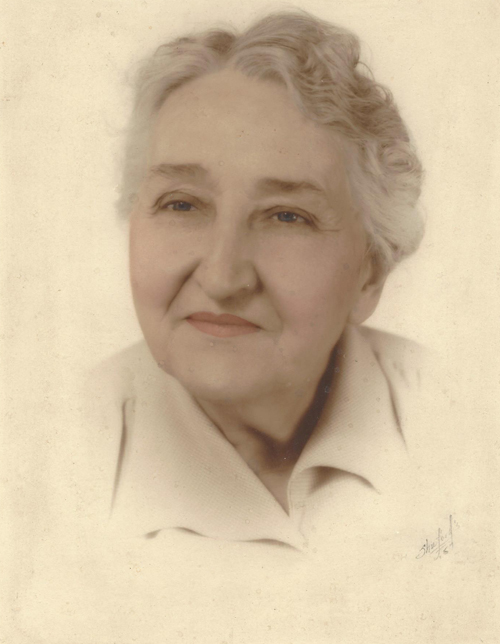
I will insert some of my favorite pixs taken in the middle to late 1960’s.
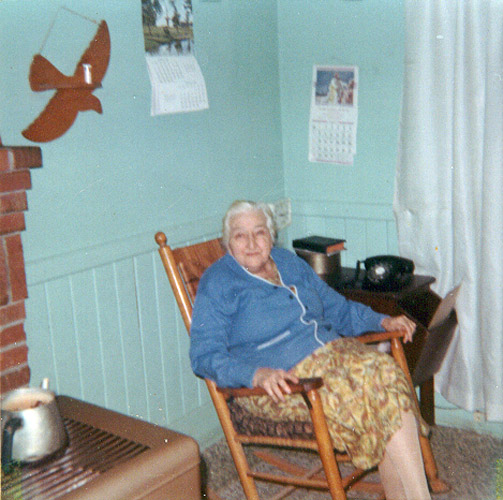
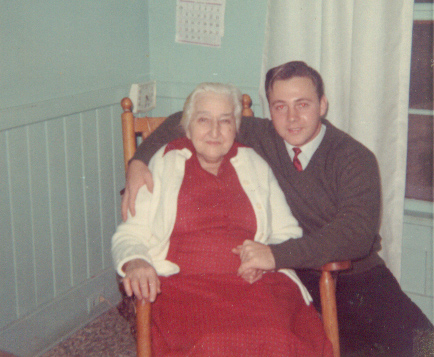
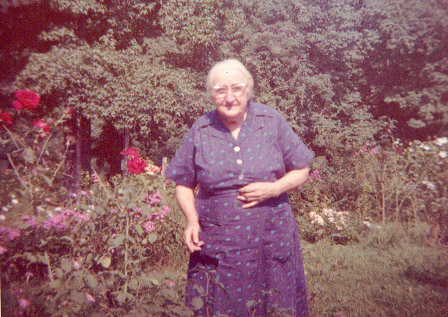
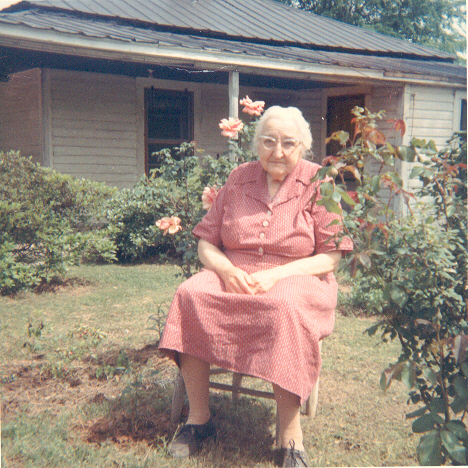
The below pix of my "bride" Joyce with Grandma taken a few weeks before
our first child was born on July 5, 1968. NOTE: She only
gained 18 pounds during the entire pregnancy! My bride and myself
stayed with Grandma Coley for a year after my US Navy enlistment was up
until we rented a
house
at 404 White Store Road that was in front of my Uncle Jesse Mack Coley who
helped us obtain the rental property which was owned by his secretary
Margaret Smith at Little Cotton Manufacturing Company.
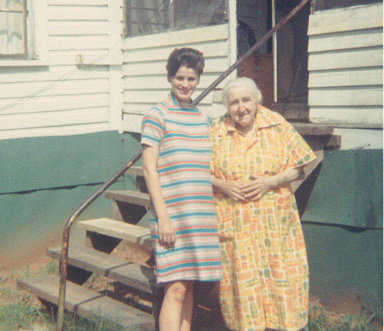
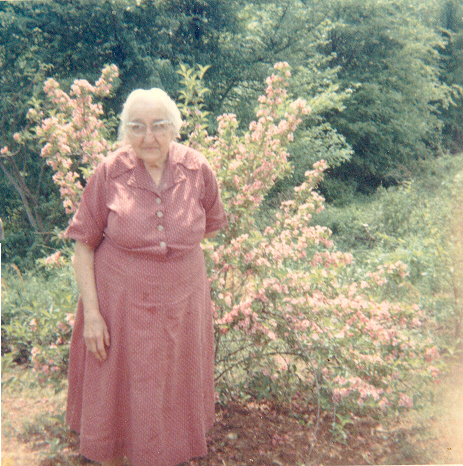
Pictures were taken in Grandma’s Rose Garden. Not knowing much about
horticulture, I can’t tell you any of the names of the various types of
roses that she grew and tenderly looked after. I remember digging many
holes with a shovel and
“mattock” helping plant and relocating the rose
bushes. Seems like she had a favorite rose bush nicknamed after her
late husband but I cannot remember the exact significant details as to how
it got that name and will do a little research to ascertain additional
information.

Picture courtesy of Ken
Ackerman and picture was probably taken sometime in the mid 1950s, just a
guess.

Picture above of Cecil Ackerman and Grandma Coley, courtesy of Ken Ackerman.
In the top right of the picture you can see part of the Anson County Water
System storage tank that was constructed sometime between 1968 and 1969
since my bride and I were living with Grandma Coley at the time along with
our new born son Billy, the time frame for the construction of the tank is
accurate. The
depth of field perception of the water tank
in the background is deceiving since the camera lenses compressed the
background (water tank) making it appear much closer than it actually is and
the water tank is a very large structure as well. Believe me, I know
how far the distance is because I have walked it probably a thousand times
or more. In good weather, I use to take a short cut from the Wadesboro
Middle/Central School that was on White Store Road and also the ole
Wadesboro High School on Camden Road; cross Highway 74 going down S.
Rutherford Street up the hill, cross Wheeler Street and go by the pre 1968
existing water tank, cross Sikes Avenue right below the crest of the hill
and then enter the Singleton Silk Mill property going by the old Singleton
Silk Mill structure and down the hill on the back side of the property using
a path that had been used since the 1900s coming up directly behind
Grandma's home. While the water tank was under construction, Grandma
use to look up at the tank during the day and would constantly pray for the
men working on the water tank and my bride and I were going by the water
tank one day and noticed that what Grandma thought were men working was a
construction crane platform hanging over the side of the water tank and my
bride told her what it was. Grandma said, "Lord what am I going to
pray for now" and we both got a good grin going. My bride told her she
could pray for the construction crew that were installing a water and/or
sewer line there on Maple Lane. Grandma Coley was a "prayer
warrior" for sure and in the left hand portion of the kitchen
next to the gas stove which was her normal place for her morning devotion
and prayer, the linoleum floor covering was worn down by the contact from
her knees and shoes over the years. I vividly remember her prayer
would start out as follows, "Lord, thank you for
letting me see the light of another day" and her prayer
wasn't a short prayer but a very long, serious and dedicated prayer with
faith to reach out and touch the Lord!
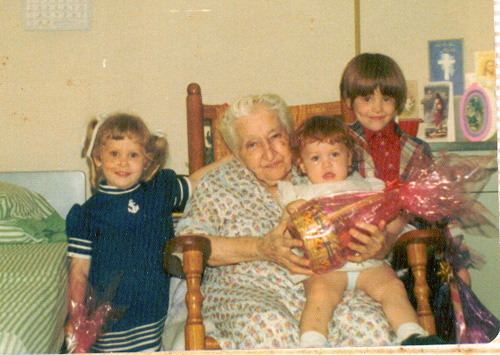
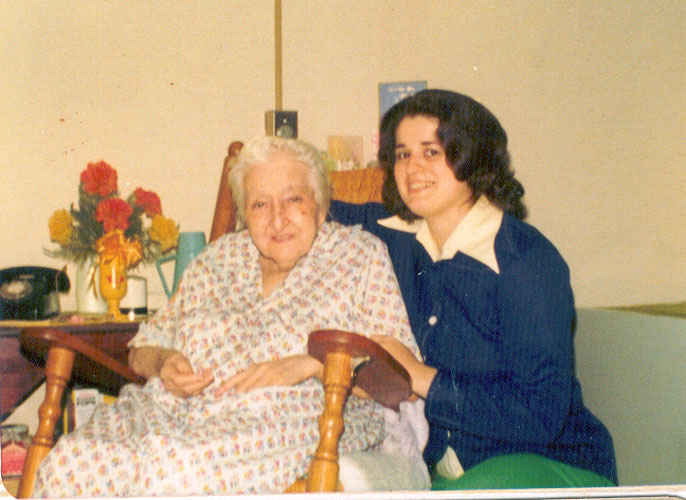
Above pictures of Grandma Coley in the Nursing Home with our young kids and
my bride and probably some of the last pictures that I took of her or that I
could find in our photo collection.
Both home places are still there and occupied today and in my mind’s eye,
all those wonderful memories from the past still linger pretty much in
focus! The landscape has changed tremendously with the pasture/field
behind the home place grown up nearly to the back door, barn and hog pens
and fencing long gone and the large sweet gum tree and elm tree in the front
yard removed, closed in back and side porches of which I used the side porch
as a weight lifting room of which I pumped many tons of iron getting my
muscles
in shape.
The majority of the people in the neighborhood from the 50s and 60s are now
deceased along with many of the original structures but they still live on
in my
mind’s eye and the pictures that have survived over the decades.
Check out my short story titled:
Does The Past Change?
CURRENT PICTURES OF PLACES MENTIONED
Below are pictures taken on 06-10-15 and I met Cylathia Borden who owns The
Coley home place at 910 Maple Lane of which she is having the place
renovated. I was invited to come back in a couple weeks when they are
finished and take some pixs of the place. While talking with Mrs.
Borden and relating some things I personally knew about her home, she
related to me a very usual story about what she had seen, heard and felt
while living in the home. She stated that sometimes the dishes would
be rattling on their own and that her bed would be moving like it had a
vibrator attached to it. The most interesting part was that both she
and her husband had seen a ghost
in the home walking around in a peaceful manner and described him to me.
She said he was a very tall man over 6 feet, had white hair, large heavy
mustache and very bright blue eyes. I told her that she was describing
my Grandfather Jesse McKnight "Mack" Coley exactly. She also said that
they got a metal detector and was looking around under the house to see if
they could find any metal objects, etc., and after that the unusual things
ceased.
I definitely plan to get back up with her and take some current pictures of
the ole home place and pick her brain a little more on those paranormal
events.
Below pix of 817 Maple Lane where the Porter family lived from 1946 until 1955 and was
sold by the Coley Heirs on January 12, 1971:
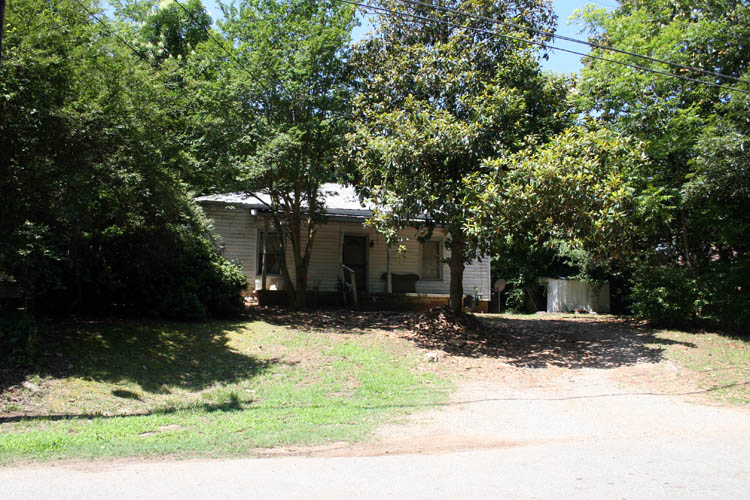
Below pix of the Doug and Hattie Coley home at 909 Maple Lane. Hattie
Coley sold the home on April 4, 1985 and moved to Lilesville and lived with
her Sister Jenny, whereas Jenny later died on September 20, 1986, whereas
the property was deeded to Hattie by the Children and Grandchildren per the
will of Emma Tucker Griffin (Jenny). The property in Lilesville
is still in Hattie Price Coley's name and her niece "Dimple" Griffin
Treadaway is listed on the tax information. I don't have contact
information for Dimple and ran across here in IGA and asked to view some of
Aunt Hattie and Doug's ole pictures but she never got back up with me and
also left word with some "branch kinfolk" also with negative results.
I have the deed hyperlink
here.
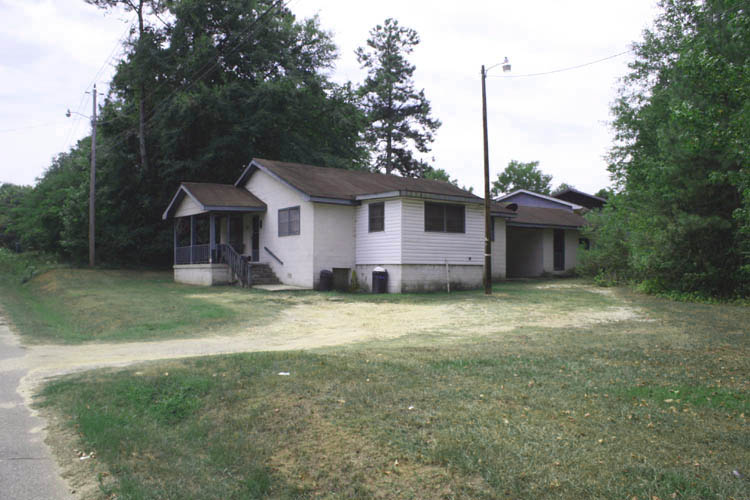
I remember when Uncle Doug added the new kitchen area adjacent the security
pole/light and also his "party room" tied into the carport in the right hand
side of the picture. There is an additional structure behind the party
room that wasn't there back in the 1960s. The house suffered an
interior fire that didn't gut the home and was remodeled after it was sold.
Doug continued to use the party room as his living quarters until his death.
Doug hosted many catfish stews in his party
room. Click on this
catfish stew recipe for his catfish stew recipe and a story to go
along with it.
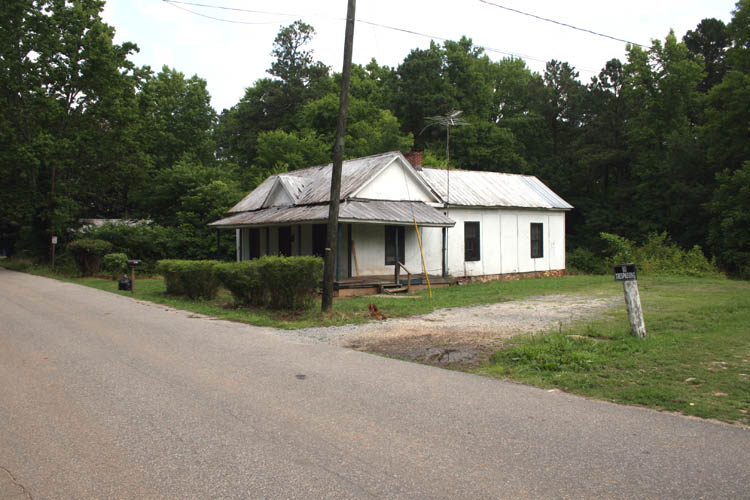
Above pix is where the Trexler family lived at 1000 Maple Lane until 1919
when Grandma married Jesse McKnight "Mack" Coley and the house was sold to
Ab and Jean Jordan from the Anson Real Estate and Insurance Company also in
1919 and Mr. Coley purchased it from the Jordans in 1930. This is also
where my
Mom and Pop lived there from 1955 until 1974 which is now a rental property
in need of some serious renovation or demolition. Aunt Sis and Uncle
Cecil Ackerman lived there in 1938 and my Uncle Doug and
Aunt Hattie Coley lived in the home in 1944 along with Sis and Ceil Ackerman
for a short period of time. Doug and Hattie stayed until they built
there home across from Grandma Coley at 909 Maple Lane.
The above home was also a rental home after Mr. Coley purchased it in 1930
and many tenants have come and gone in that ole house of which it is sad to
see it in such bad shape today. I can only imagine the hardships the
families endured before they had running water and an indoor bathroom since
it is to my understanding the outhouse was located behind the barn on the
Coley home place next door at 910 Maple Lane, whereas two families had to
use the outhouse! I can tell you from
personal experience, an outhouse is not a place you want to
linger in no longer than absolutely necessary!
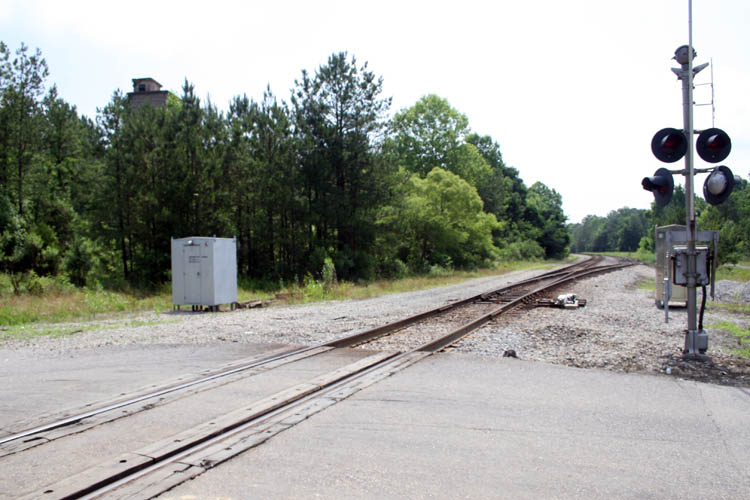
The Wadesboro Depot is long gone and just a
memory from the past. I went into the wooded area in
the approximate vicinity where the ole 1930s two story boarding house would
have been, but it is heavily grown over with vines, etc. and could not make
a positive identification.
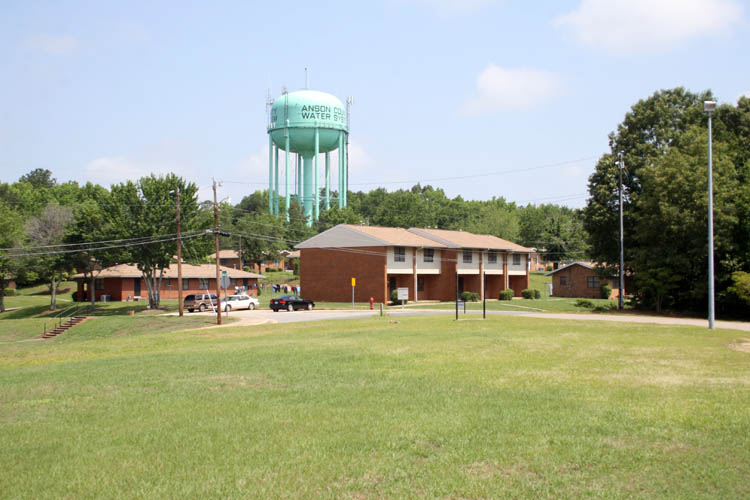
Above picture where the Singleton Silk Mill was located and the two story
main factory (three stories counting the basement) was located near the
water tank of which the summit or plateau of this property goes back a good
distance before it starts to drop off. The Singleton Silk Mill
property encompassed the entire area where the housing development is
currently at and there were several other structures still standing in the
early to mid 1960s until they were demolished and/or burned down and the
water tank was erected before the housing development.
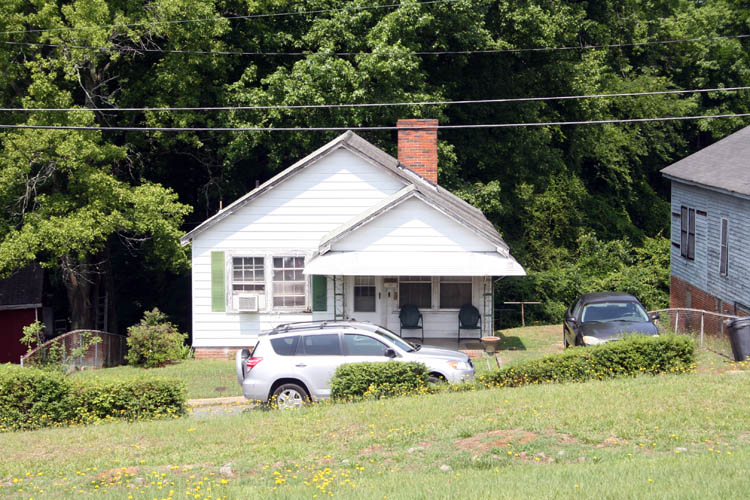
This is the last home place where Mary Helen Coley was raised by Odell and
Virginia Mowery Williams after living at a couple other locations; e.g.,
Wheeler Street and Burnsville Street.
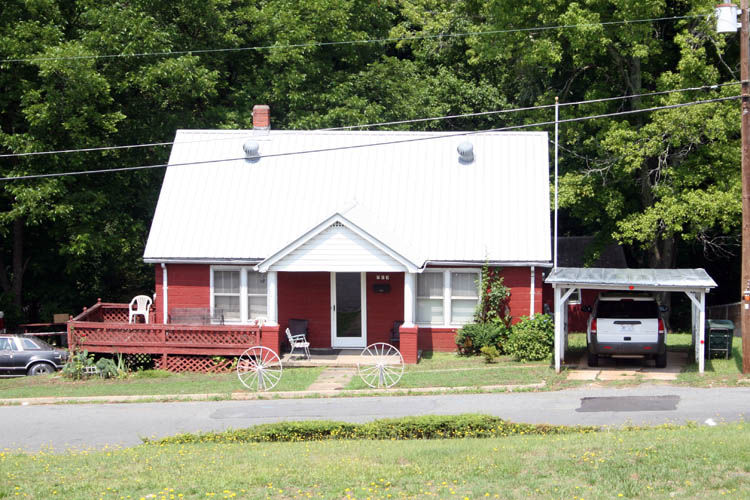
Above home that Jesse Mack Coley, Jr. built at 713 Sikes Avenue and lived
there until he purchased his last home below at 403 White Store Road. When
they lived on Sikes Avenue, there was no deck, car shelter or buildings in
the back yard. Below is the home at 403 White Store Road:
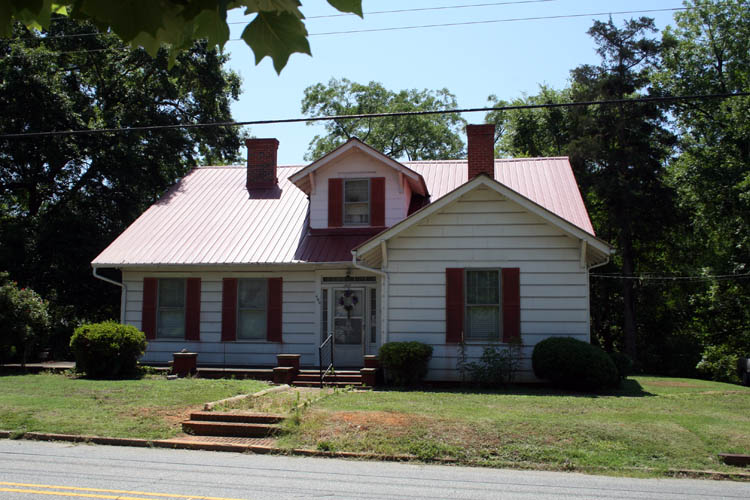
Below is the former Ackerman home at 308 Sandy Ridge Church Road in Morven,
NC where the 40 plus acres of Land that Mr. Coley & Della deeded to them of
which has been subdivided out since then. The original home has had
extensive remodeling and renovation since the way I remember it prior to
1957 which was just blocks with no siding or the addition to it and other
buildings in the back. Also, there are many homes on the original
property plus a trailer park on the far back side of the property as well.
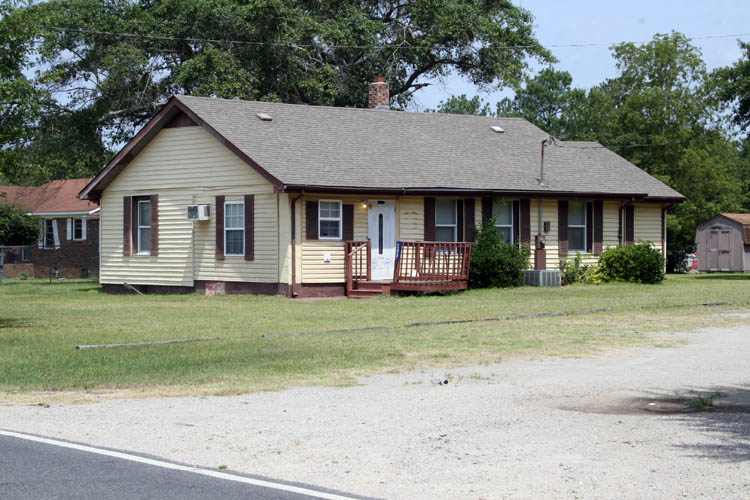
Below home that Cecil Ackerman built in 1957 and stayed there until they
moved to Charlotte, NC in 1965 and was a rental property until it was sold.
Cecil and Sis lived in Indian Trail until their death.
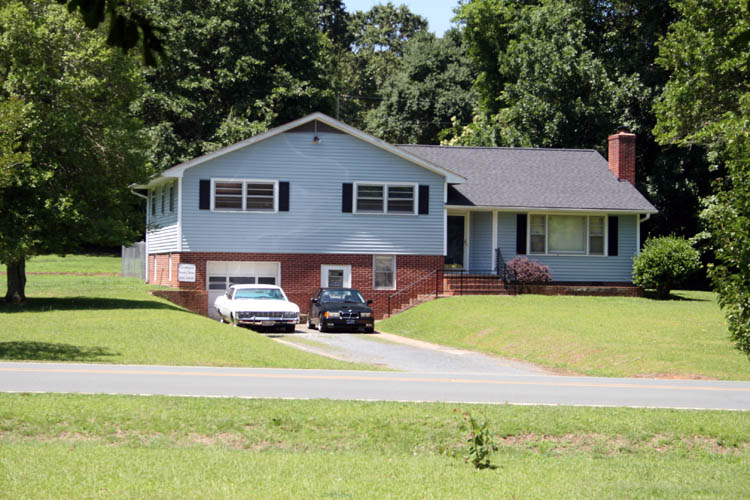
My bride and myself looked at the Ackerman built home above prior to 1989
and was interested in purchasing it from Aunt "Sis" but Don Scarborough of
Plank Road Realty explained to us the property consisted of several lots of
which the home was not correctly listed on the center lot of the plat and
would have to get the signature of each family member before it could be
sold. We declined to purchase the home since we were anxious to
purchase our own home without further delay!
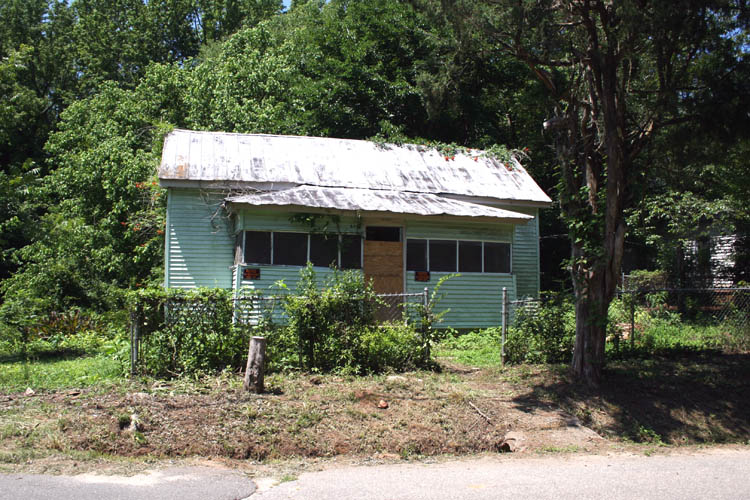
Above is one of the homes that Mr. Coley purchased back around 1940 located
at 815 Maple Lane and known as the Frank Shaver Lot on Maple Lane of which
was not a part of his original land purchase of properties on the West Side
Extension Plat which borders this lot. Time and lack of maintenance
has taken its toll on this property and it would be cheaper to demolished
than renovate in my humble opinion. I believe Alice Covington
rented that home in early 1950s to the early 1960s and her Mother "Aunt
Virginia" helped my Grandma and Mom back then do domestic work. This
house was sold by the Coley Heirs on January 24, 1975 along with
two additional homes at 910 Maple Lane, 1000 Maple Lane and the adjoining
lot which went down to a branch. The majority of those original ten
(10) homes purchased from the Singleton Silk Mill have been demolished and
replaced with more modern homes but I can still visualize most of them in my
mind's eye when they were in much better shape or appeared to be at that
time.
TIME WAITS FOR NO ONE AND THE CYCLE OF LIFE
CONTINUES UNTIL JESUS CHRIST OR LORD AND SAVIOR CALLS US HOME OR THE
RESURRECTION TAKES PLACE!
In conclusion, all of the Jesse
McKnight "Mack" Coley immediate family members from both marriages are
deceased
except for one remaining Daughter, Aunt Mollie Irene
Bowers of Burnsville, NC. As a small boy, I remember Mom and Pop
driving our family to visit Clifford and his wife Dora who lived near the
Reed Gold Mine in Cabarrus County.
Clifford was one of Mr. Coley's sons from his
first marriage who rented a good sized farm there in Georgeville, NC.
Clifford was a retired Postmaster and raised beagle hunting dogs for sale.
Clifford would release the dogs and it wouldn't be too long before his pack
of beagles would jump a rabbit and the race would be on with some beautiful
music in the air.
Nearly all the renters from the Coley rental houses, like most of the wood
frame houses are gone and just a memory from the
past and once in a "blue moon" will run into one of their
children and/or grand children which were very young at the time and we will
recognize each other and talk about ole times.
MY LAST WORDS TO GRANDMA COLEY
It seems like only yesterday that those early
pictures were taken of my Grandma Coley but time waits for no one.
My Grandma was in the local hospital a few days before anyone told me she
was there and I do believe she held on until we could have our last words
and visit together. We talked about many things and she told me how
much she loved me and I did the same. My last words to Grandma at the
hospital were, “I’ll see you in the morning”
and she replied,
“I hope so Son.” It will
have to be the
Resurrection
morning because she died in her sleep on October 19, 1974!
Written and web published by Bill aka Mickey Porter on 10-23-04 with
updated pixs on 12-06-14, 06-06-15, 06-07-15, 06-08-15, 06-10-15,
06-11-15, 06-13-15, 06-15-15, 06-17-15, 06-18-15, 06-23-15, 06-25-15,
06-30-15, 07-02-15, 07-05-15, 07-11-15, 07-14-15, 07-15-15, 07-23-15,
07-28-15, 07-29-15, 08-01-15, 08-02-15, 08-05-15, 08-06-15, 08-11-15,
08-12-15, 08-13-15, 08-14-15, 08-16-15, 08-20-15, 08-21-15, 08-24-15,
08-26-15, 08-27-15, 09-16-15, 09-17-15, 09-25-15, 10-02-15, 11-01-15 and
04-10-16.
A special
Thank You to the wonderful Ladies at the
Register of Deeds Office here in Wadesboro, NC for their help
getting me started searching the records and assistance as needed.
ABOUT THE AUTHOR
I was born William McKnight Porter on February 7, 1946 in Wadesboro, North
Carolina, the first of four children. I graduated Wadesboro High
School in 1964 and enlisted in the US Navy, August of that year.
Following boot camp in Great Lakes, Illinois, I attended a six month
Radioman Class A school in Bainbridge, Md. I was transferred to
Morocco, Africa at a communications relay station and worked at the
communications receiving site which handled communications to the 6th fleet
ships.
After two years in Morocco, Africa, I was transferred to the Naval Air
Station in Norfolk, Virginia and specialized in Crypto and our group was
called Manned Spacecraft Recovery Force Atlantic TF-140 and participated
with the NASA program. I attended the unmanned Apollo 6 mission in
Cape Canaveral, Florida in 1968 and stayed a week before and a week after
the April 4, 1968 launch.
While still in the US Navy at the Naval Air Station in Virginia, I married
Joyce Adcock of Wadesboro, NC my grade school sweetheart and we have been
married for over fifty-five (55) years and she is still the love of my life.
We have one son, two daughters, five grandsons and one granddaughter.
After a four year tour of duty with the US Navy in 1968, my bride and myself
returned to Wadesboro, NC and I went to work with the North Carolina
Telephone Company in Marshville, NC and installed and repaired two-way
radios, mobile telephones and later transferred to the Wadesboro office
installing and repairing special communications equipment. During that
time, I formed a mail order business in 1969 for stringed musical parts and
accessories, cutting and inlaying Mother of Pearl, Abalone Pearl and
fabricating pre-war reproduction metal parts, repairing stringed
instruments, etc. I sold the business in 1978. I also attended
the local community college and majored in Business Administration and
Industrial Management earning a two-year degree in both.
In 1979, I went to work with the N. C. Department of Correction as a
Correctional Officer and over a thirty-three (33) year career had a variety
of duty assignments including: Administrative, Transportation, Clothes House
Supervisor, Key and Lock Control Officer, Firearms Instructor, General
Instructor, Unarmed Self-Defense Instructor, Firing Range Officer and Armory
Officer, created and maintained data bases for the inventory and purchase of
associated equipment and supplies, etc.
In 1986 while working with the NCDOC, I formed W. M. Porter Co., Inc. and
manufactured metal climbing tree stands and awarded two US Patents,
4,952,668 and 5,167,298 and sold the company and rights to the
tree stands in 2000.
I retired in 2012 and enjoy many hobbies including, photography both nature
and food, hunting; e.g., archery, firearms, muzzleloading aka black powder,
fly fishing and regular fishing, wood working, occasionally building a
musical instrument, banjo and Dobro and thumping on their strings.
When the internet became of age, our son William, Jr. helped me get up to
speed and create my own website of which I write short stories, hunting
stories and have a Recipe page complete with a pictorial essay of most of
the recipes that I do. Food styling is another hobby too!
I give God through Jesus Christ our Lord and Savior the praise, glory and
honor in all things.
This short story is dedicated to the memory of my Grandma Della Coley!
LEAVING ON A SPIRITUAL NOTE
If you do not know Jesus Christ as your Lord and Savior, please take this
moment to accept him by Faith into your Life, whereby Salvation will be
attained.
Ephesians 2:8 - 2:9 8 For by grace are ye saved through faith;
and that not of yourselves: [it is] the gift of God: 9 Not of works, lest
any man should boast.
Hebrews 11:1 “Now faith is the substance of things hoped for, the
evidence of things not seen.”
Romans 10:17 “So then faith cometh by hearing, and hearing by the
word of God.”
Open this
link about faith in the King James Bible.
Romans 10:9 “That if thou shalt confess with thy mouth the Lord
Jesus, and shalt believe in thine heart that God hath raised him from the
dead, thou shalt be saved.”
Open this
link of Bible Verses About Salvation, King
James Version Bible (KJV).
Hebrews 4:12 “For the word of God is quick, and powerful, and
sharper than any two edged sword, piercing even to the dividing asunder of
soul and spirit, and of the joints and marrow, and is a discerner of the
thoughts and intents of the heart.”
Romans 6:23 “For the wages of sin is death; but the gift of God is
eternal life through Jesus Christ our Lord.”
Romans 3:23 “For all have sinned, and come short of the glory of
God;”
Micah 6:8 “He hath shewed thee, O man, what is good; and what doth
the LORD require of thee, but to do justly, and to love mercy, and to walk
humbly with thy God?”
Philippians 4:13 "I can do all things through Christ which
strengtheneth me."








